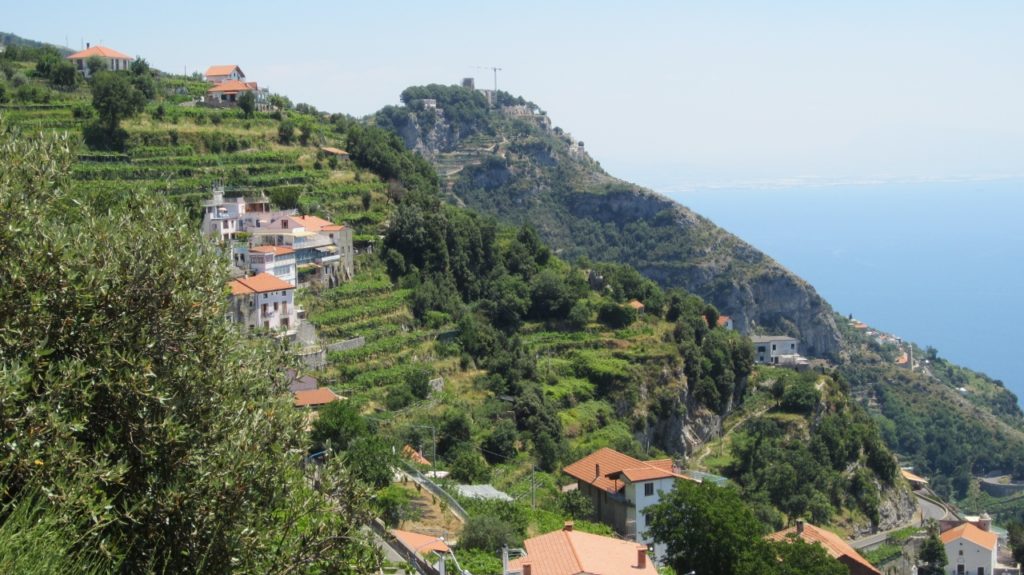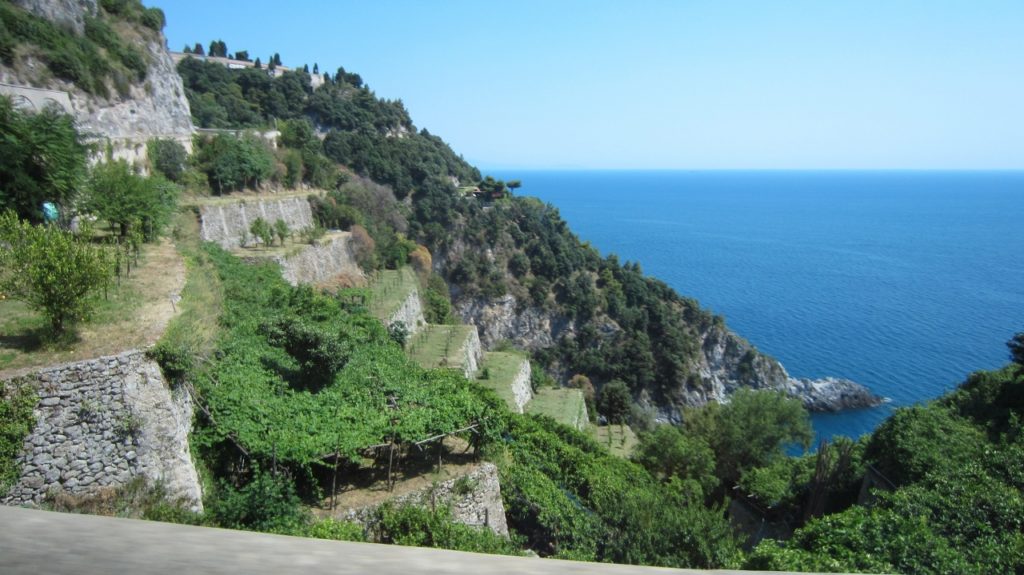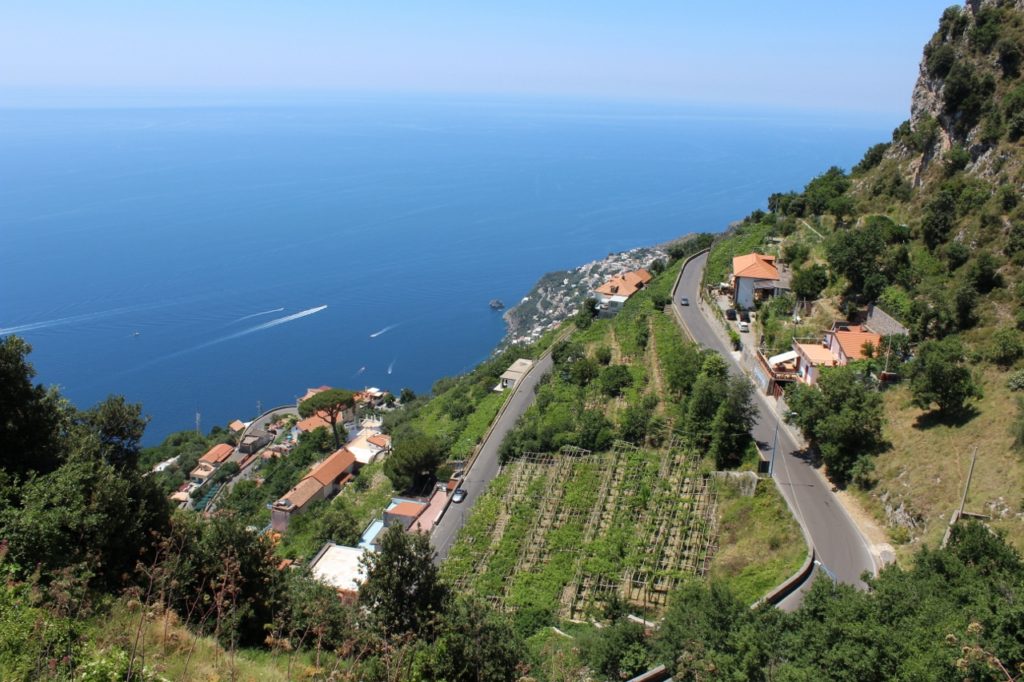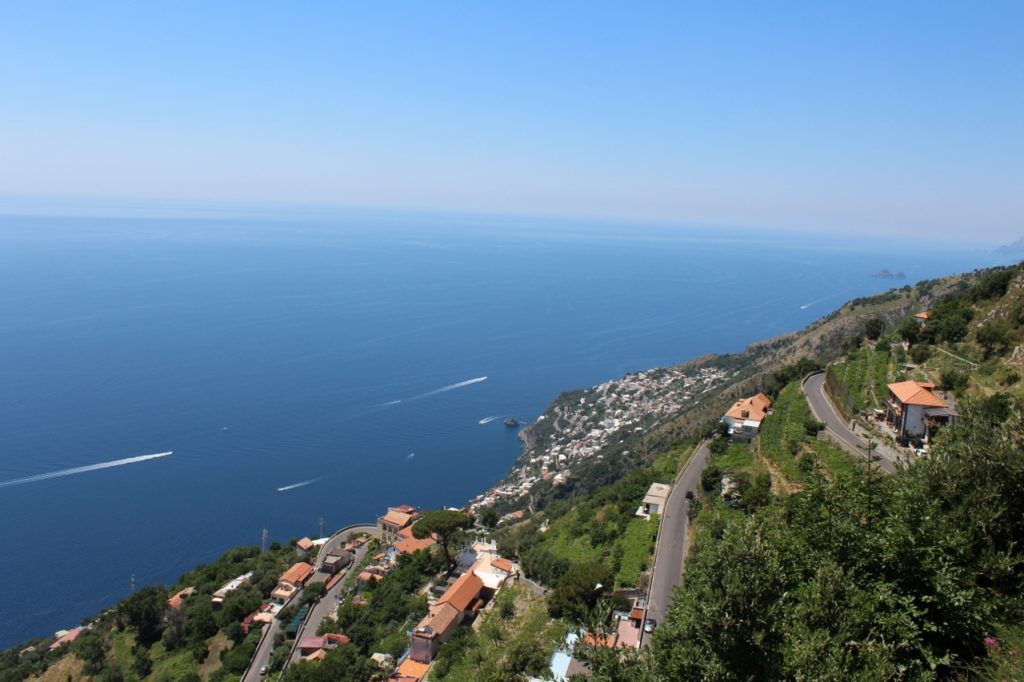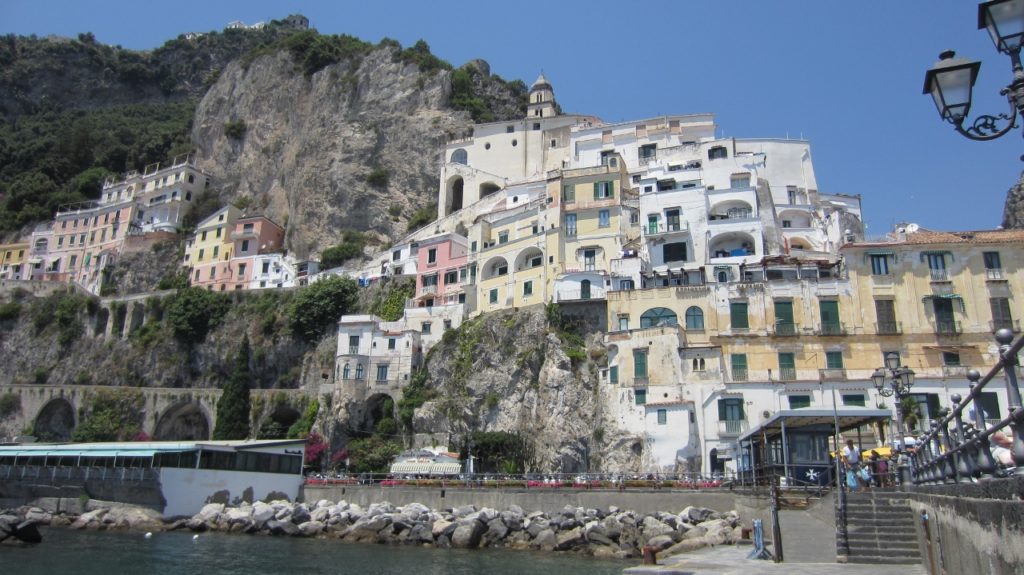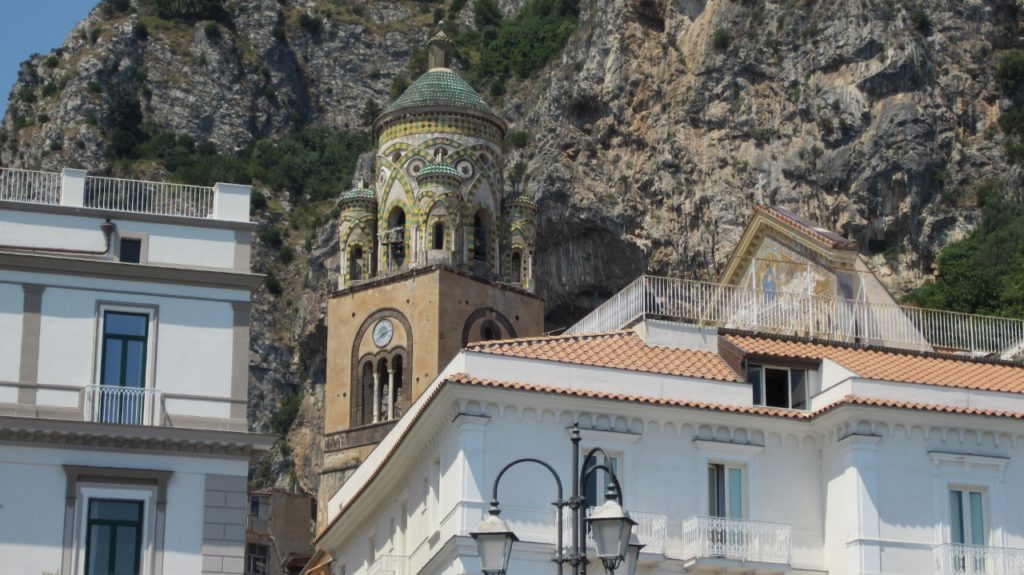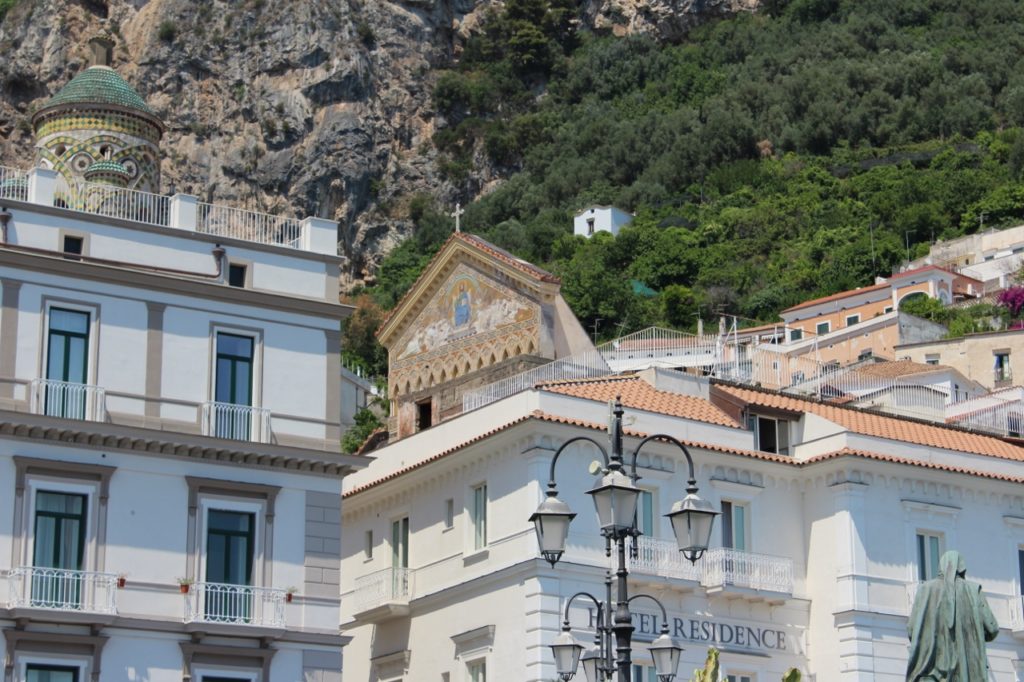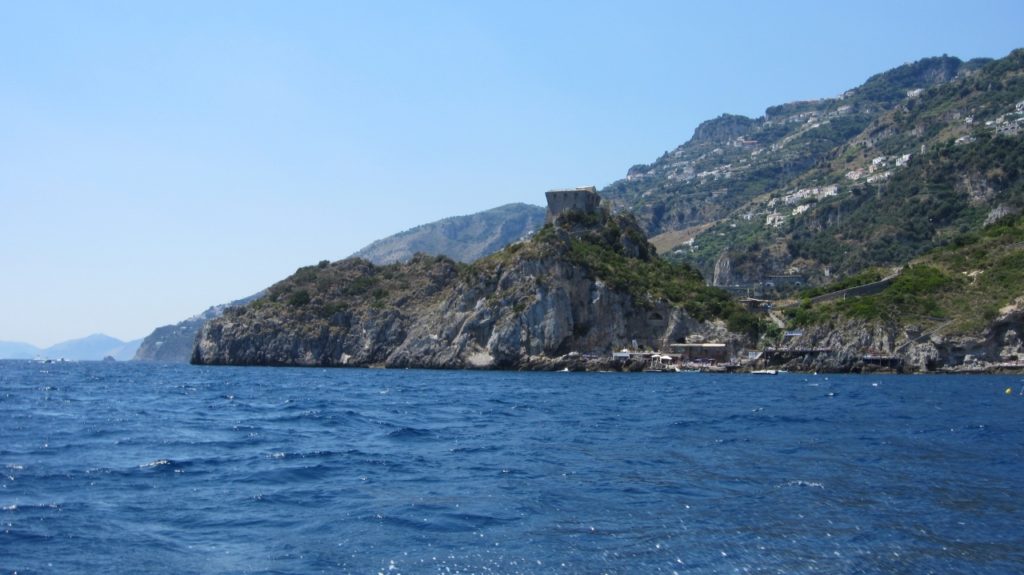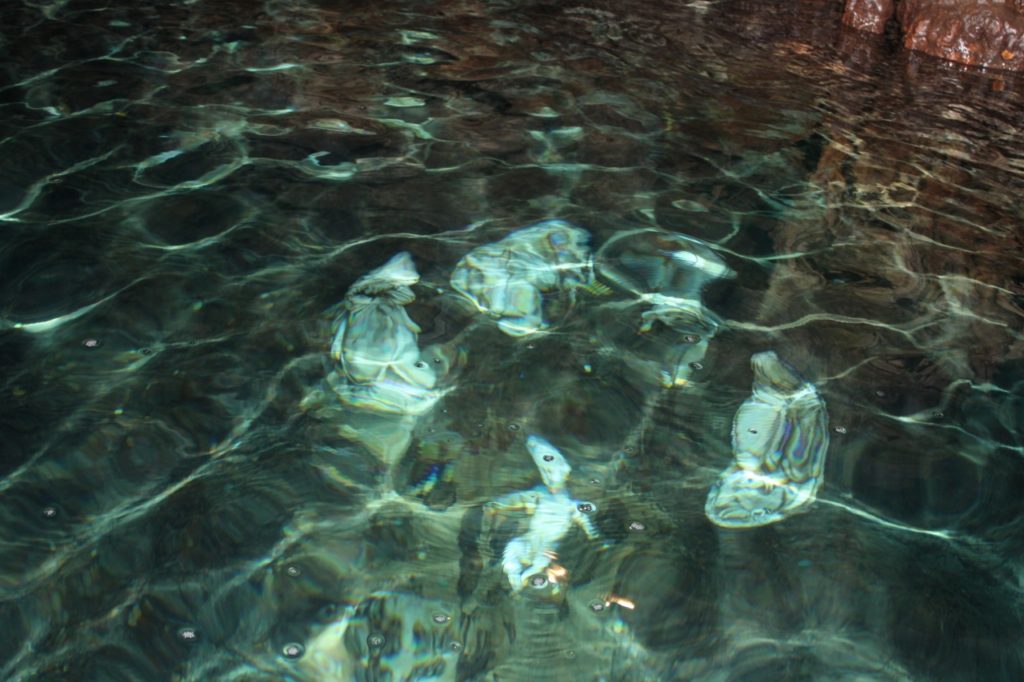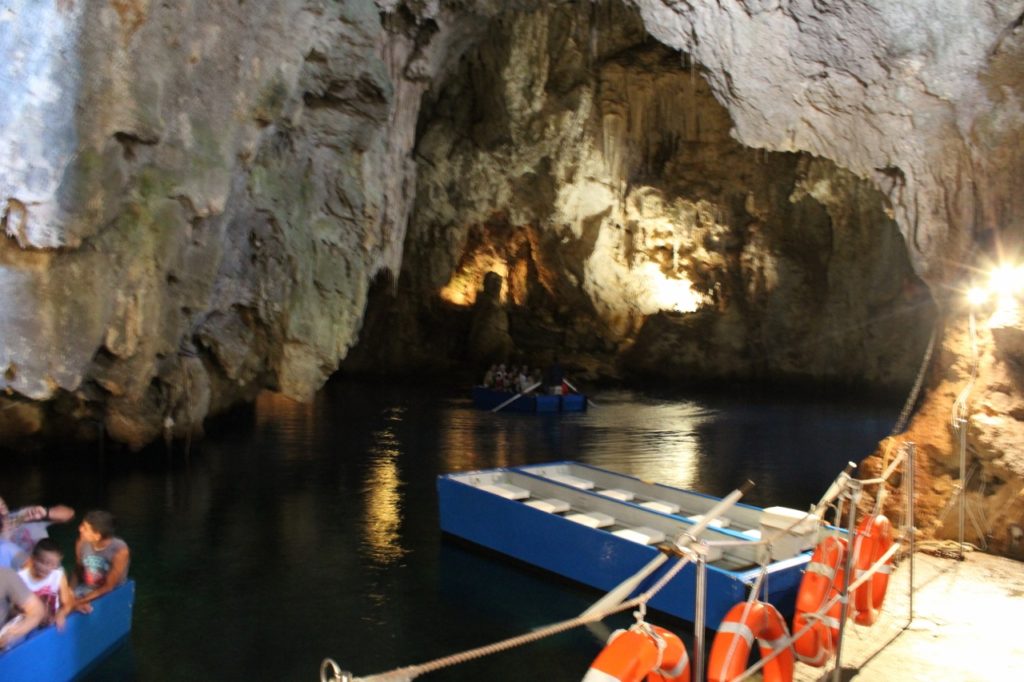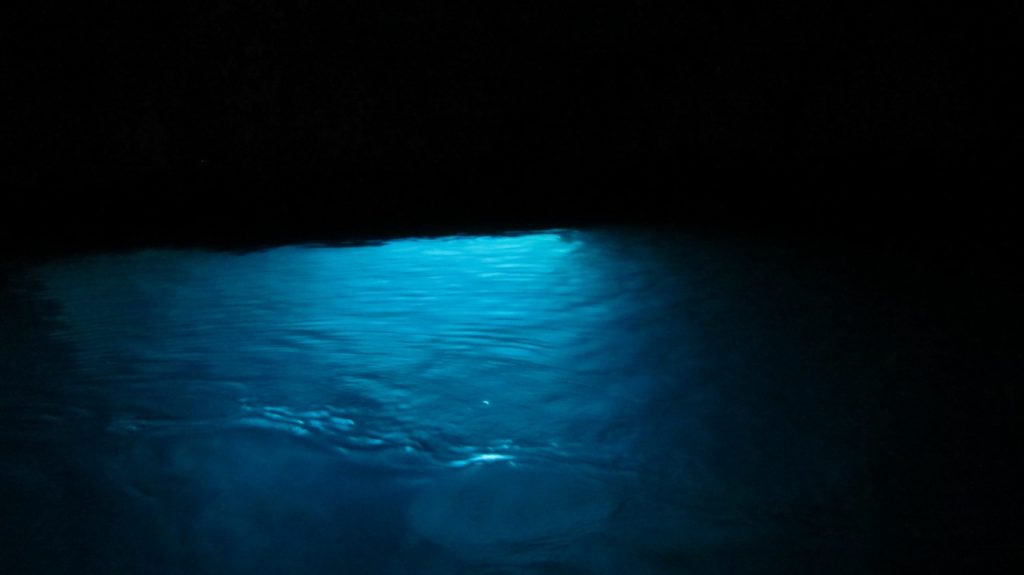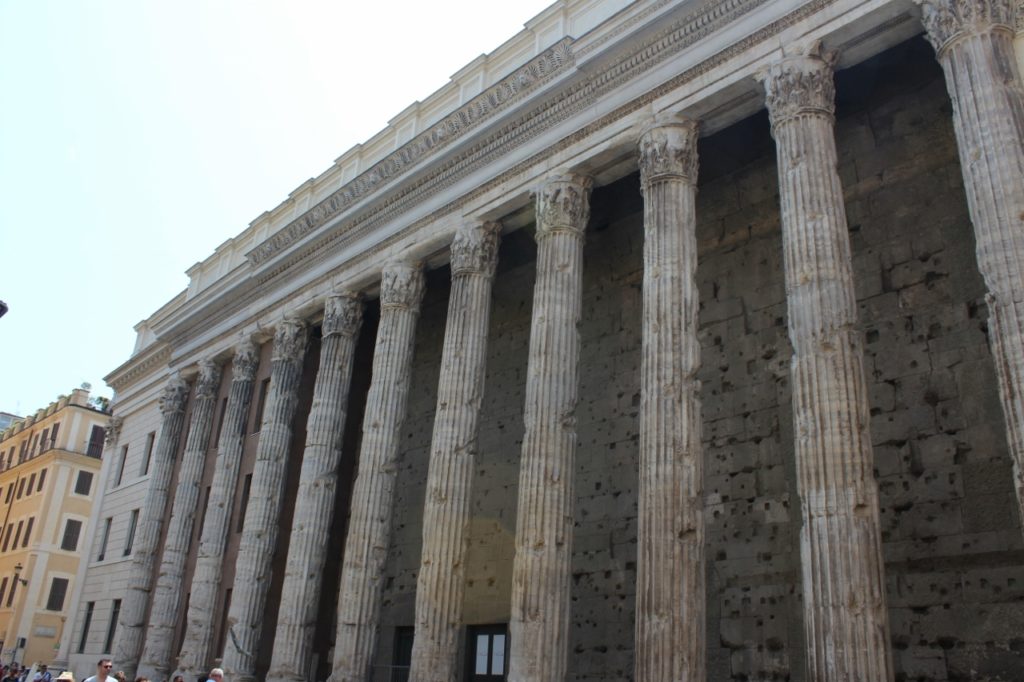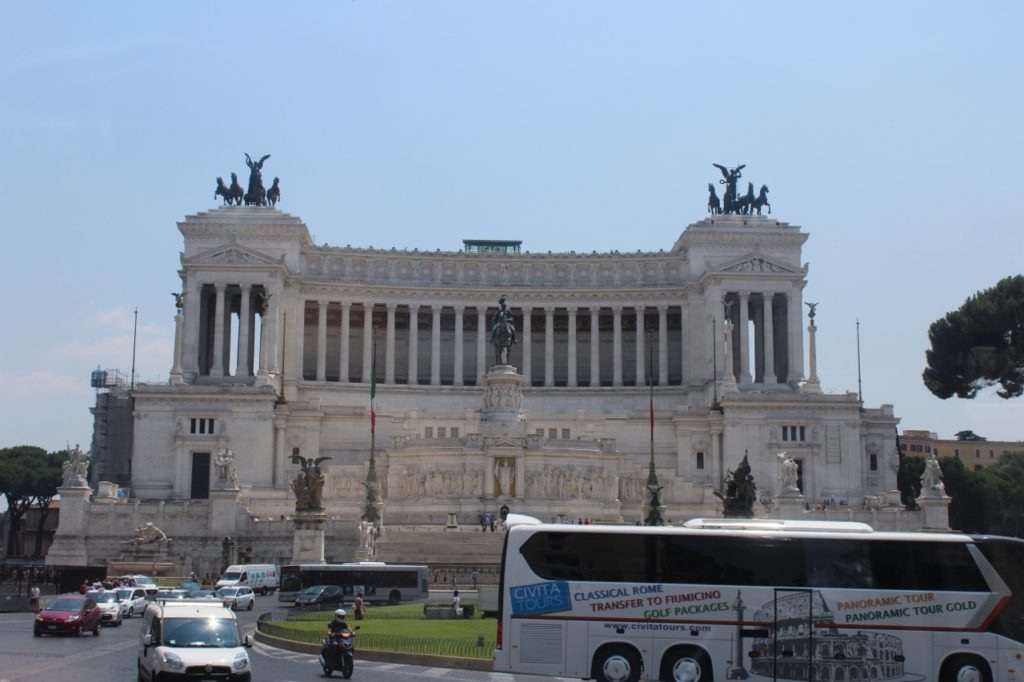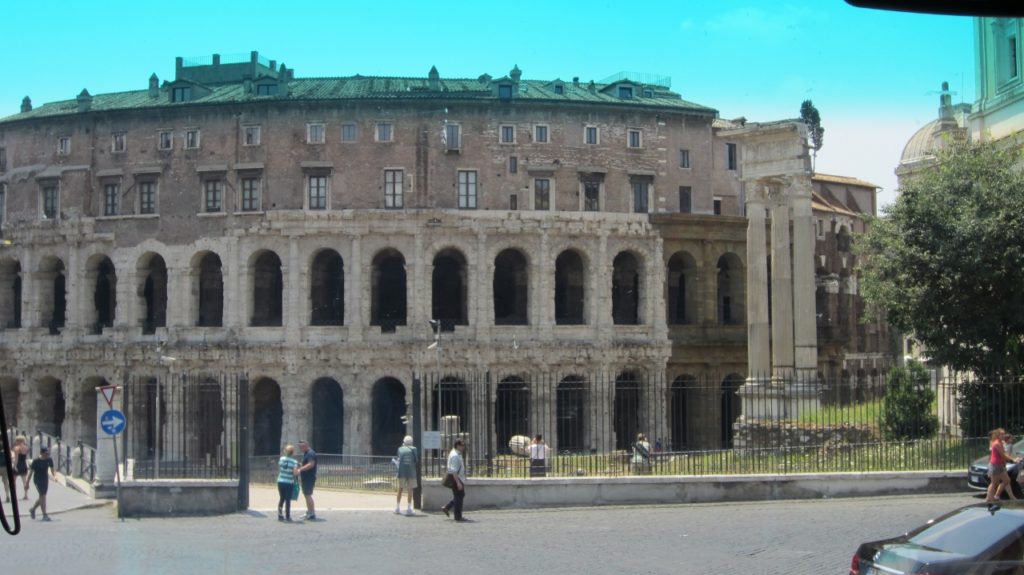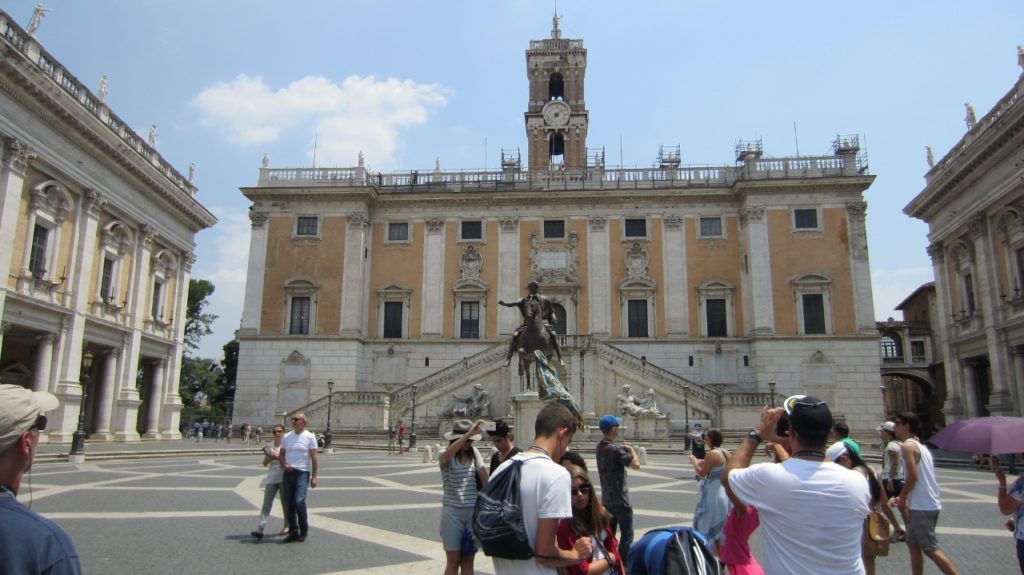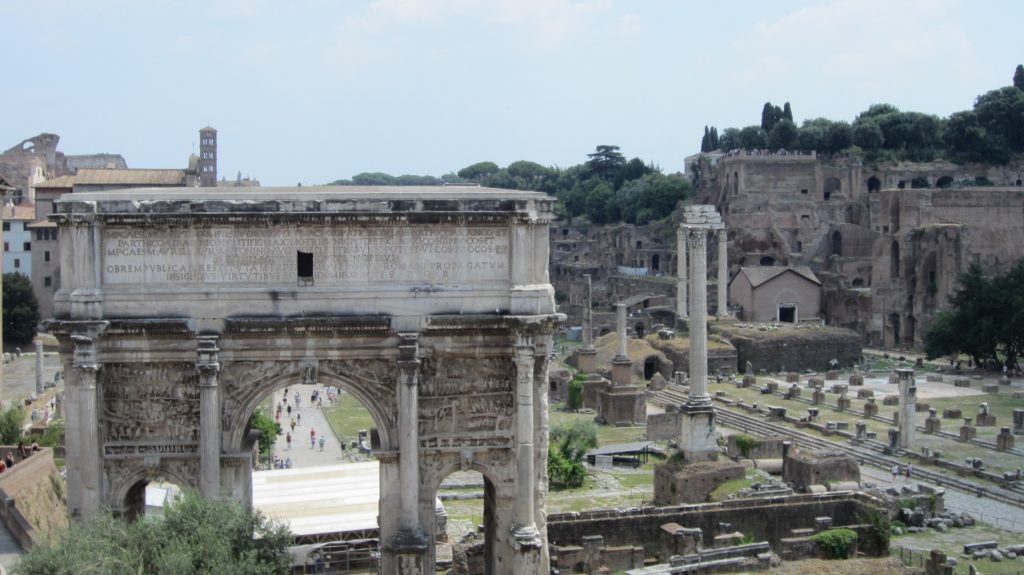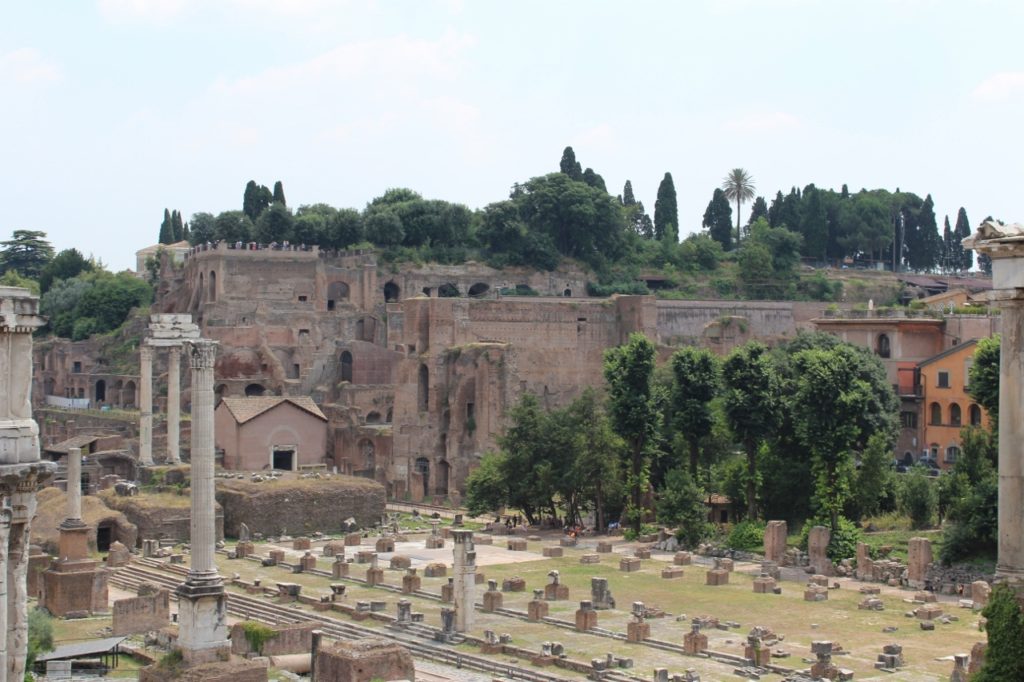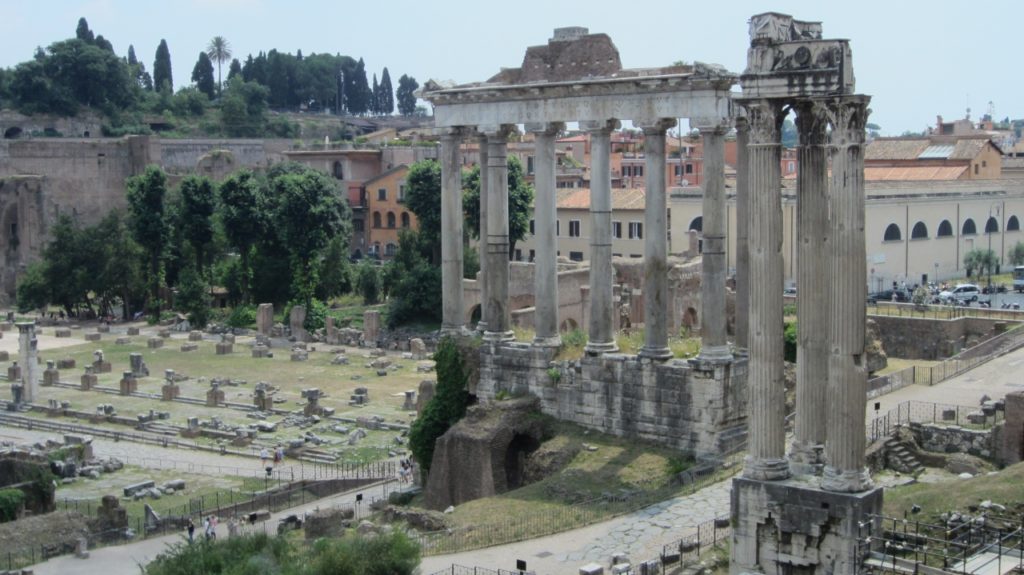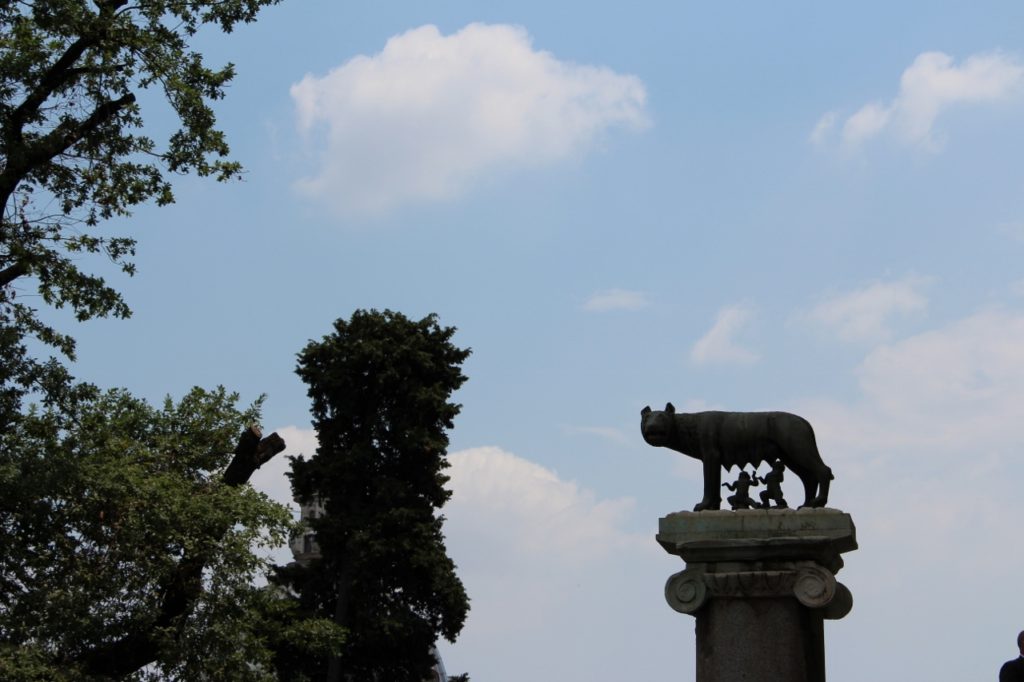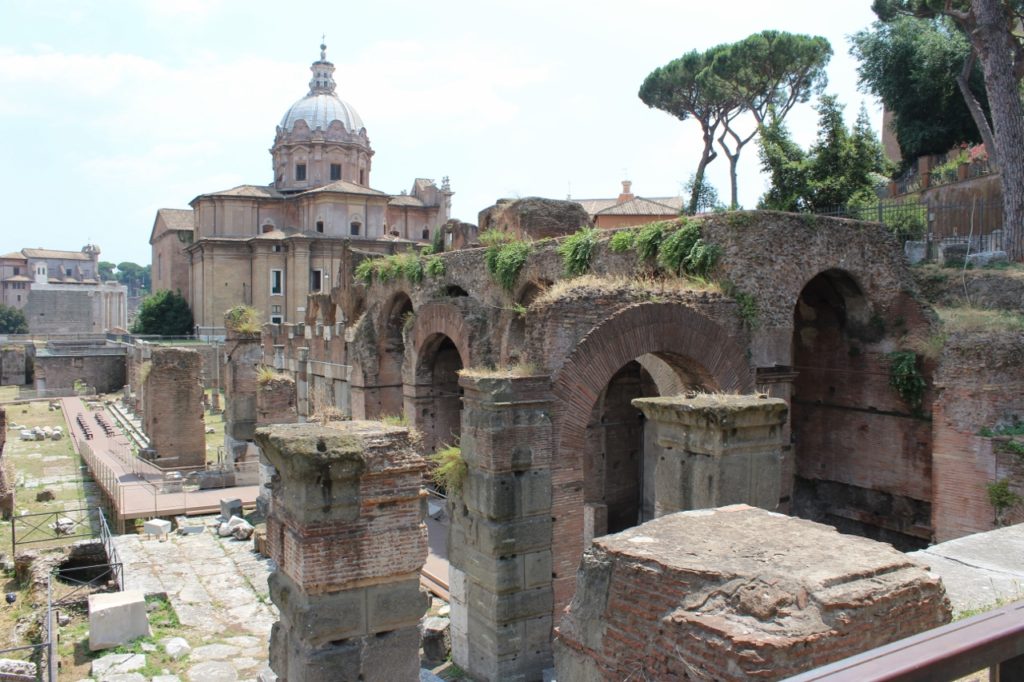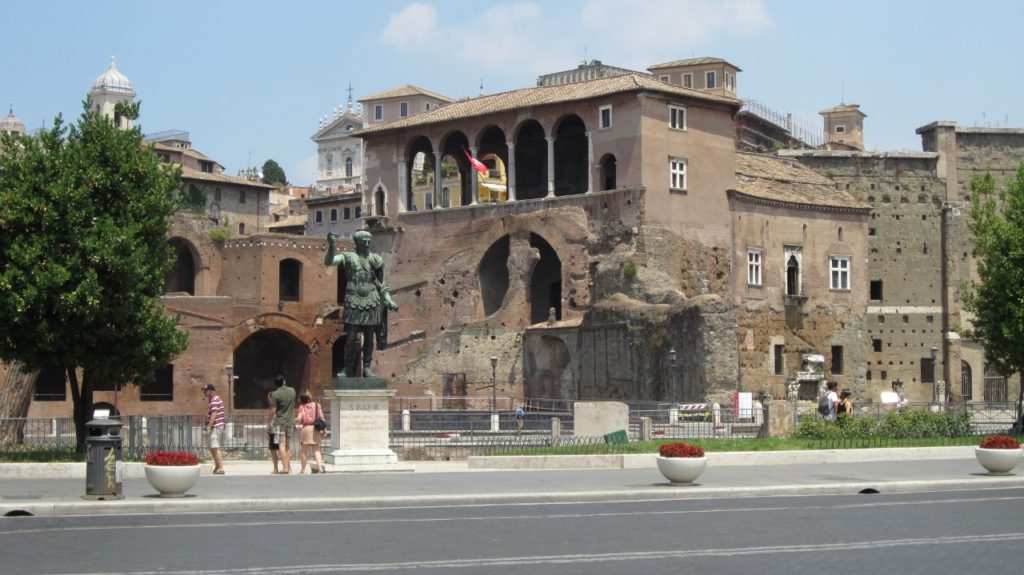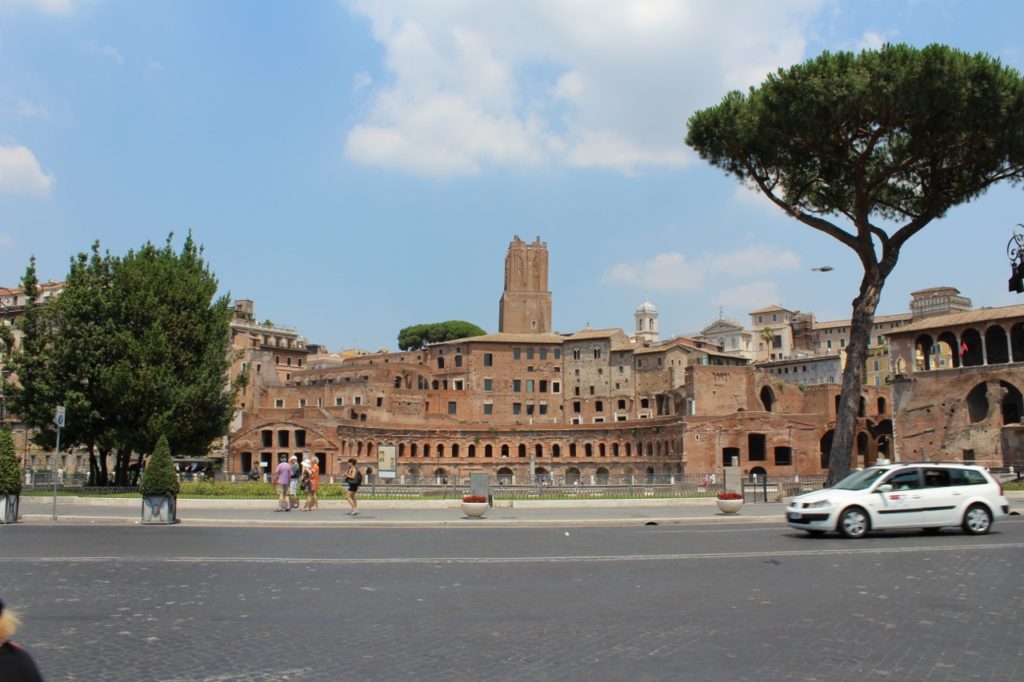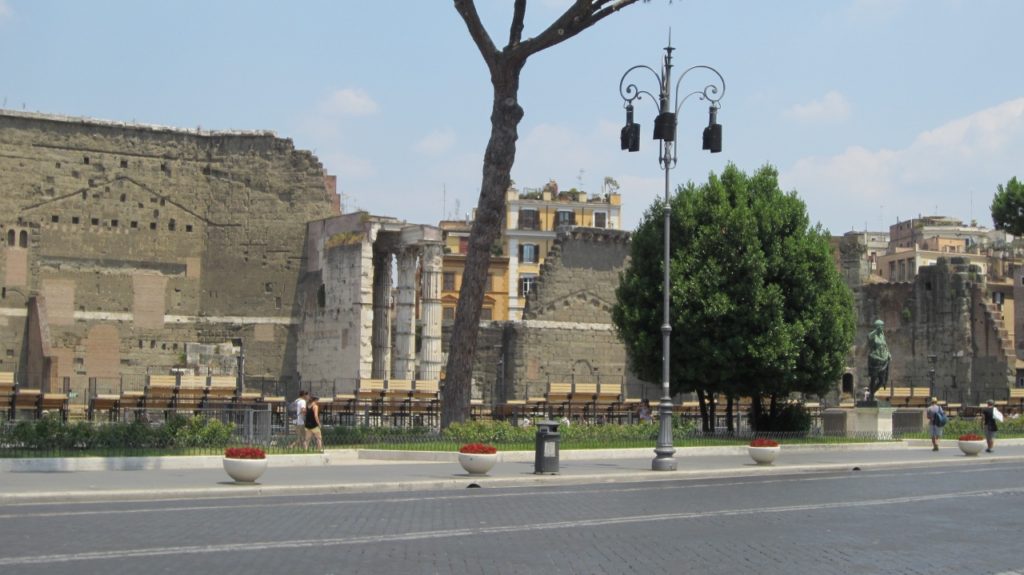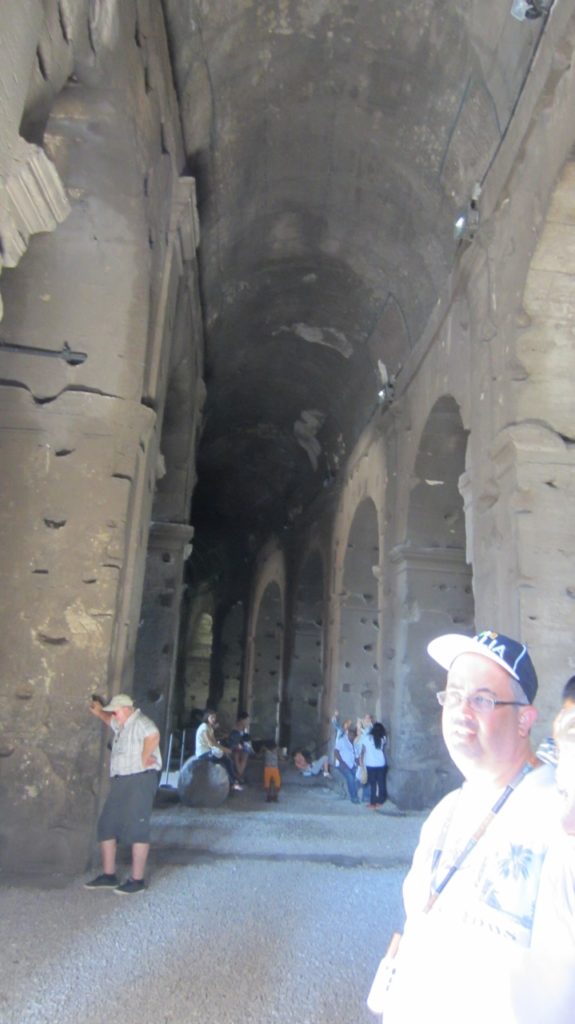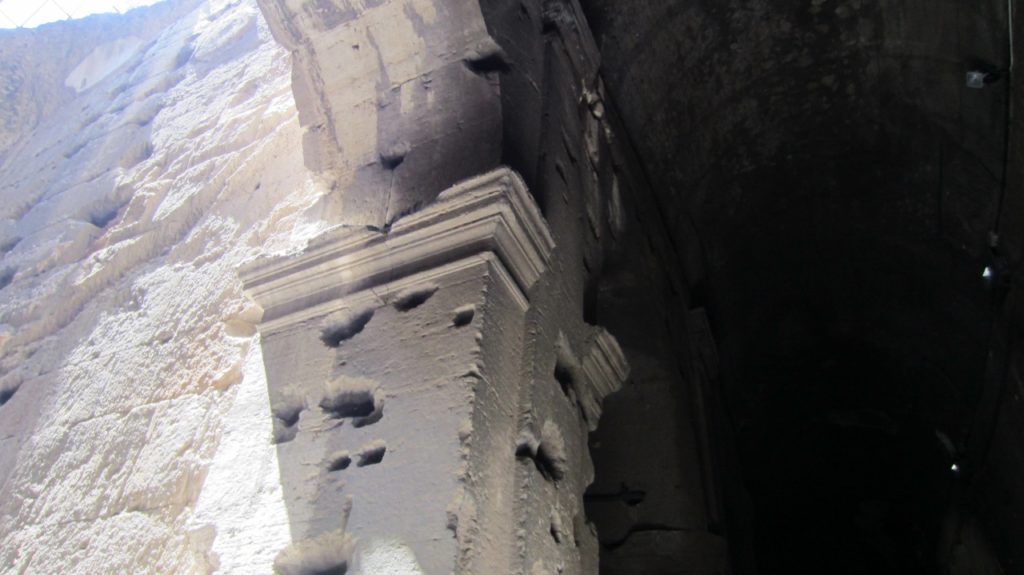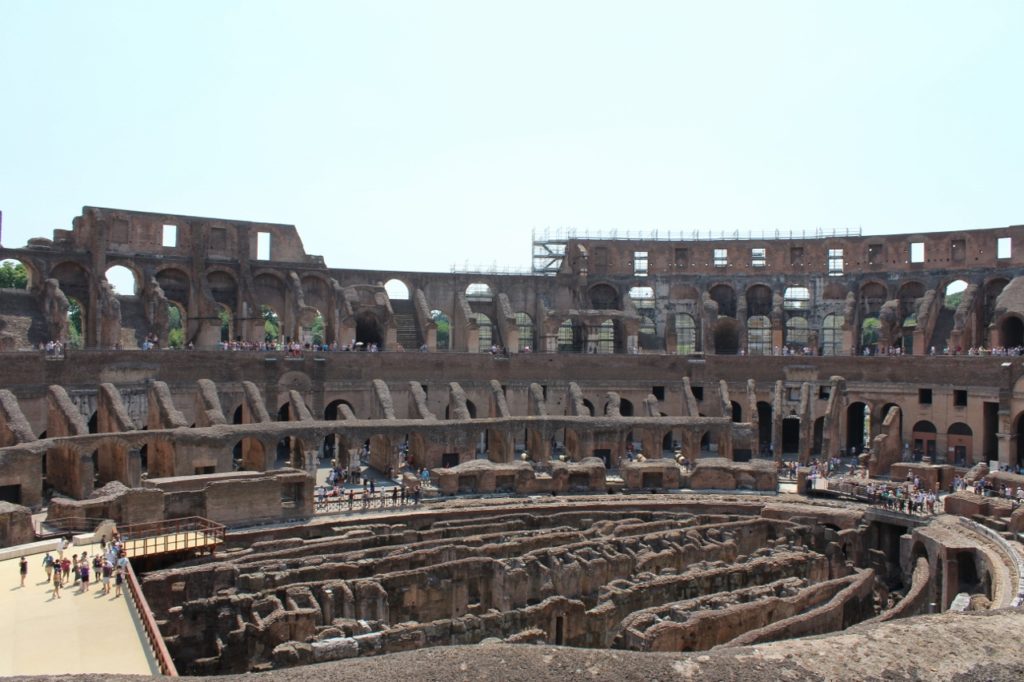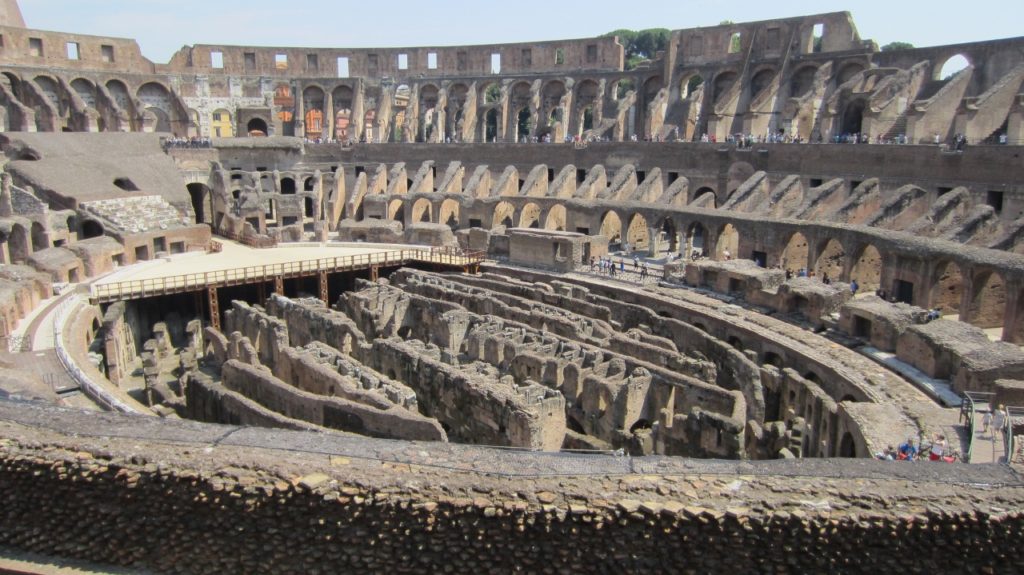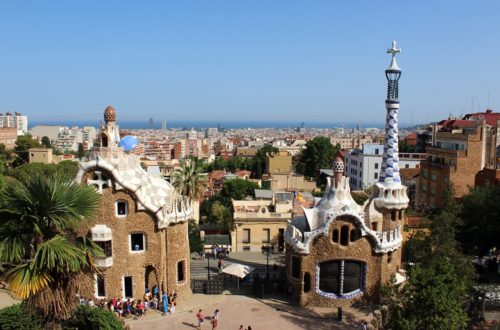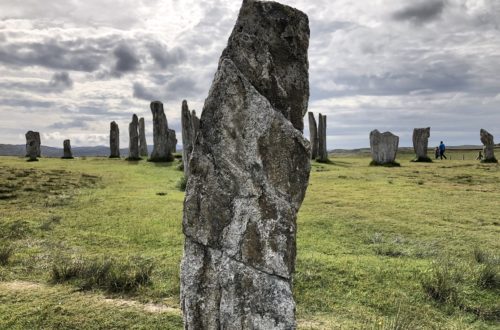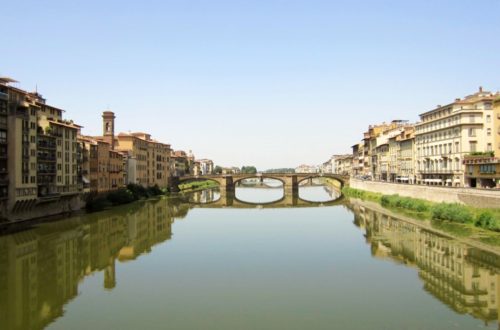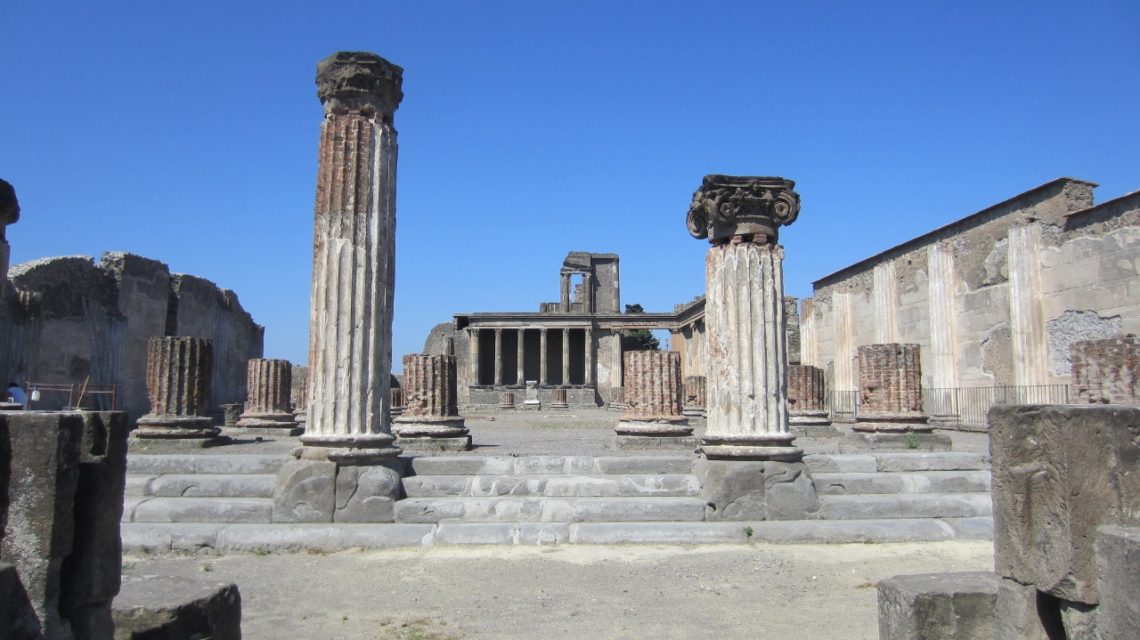
Mediterranean Cruise Series Episode 3 Naples & Rome
All roads lead to Rome, and that is true in the case of this post! Welcome back to our Mediterranean Cruise adventure! After exploring Greece and Turkey, day 7 was another day at sea while we cruised to the eastern coast of Italy. This was the day for one of my embarrassing moments. I completely forgot about the dress code at the Windows Dining Room, and got sent to change out of my capris into pants! Oops! This evening we cruised through the Strait of Messina and watched the sun set over Sicily and Mount Etna. It was gorgeous! We were also going to pass by Stromboli, Italy’s most active volcano, but not until 3:00 am so I missed it. We had two big days ahead, and I knew I would be visiting Stromboli in person on my next trip to Italy!
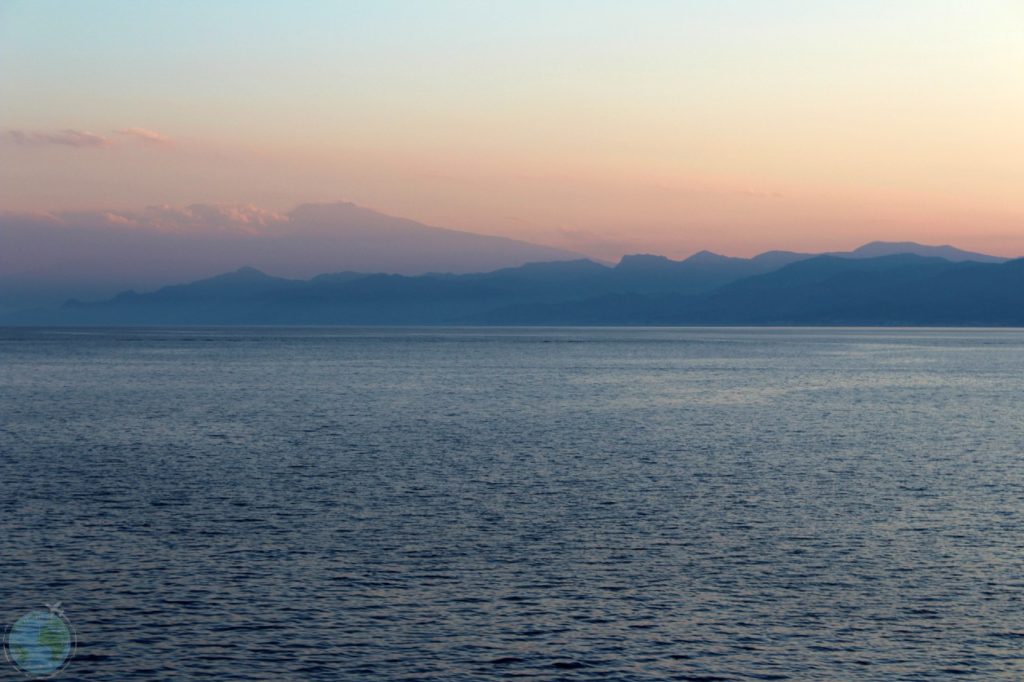
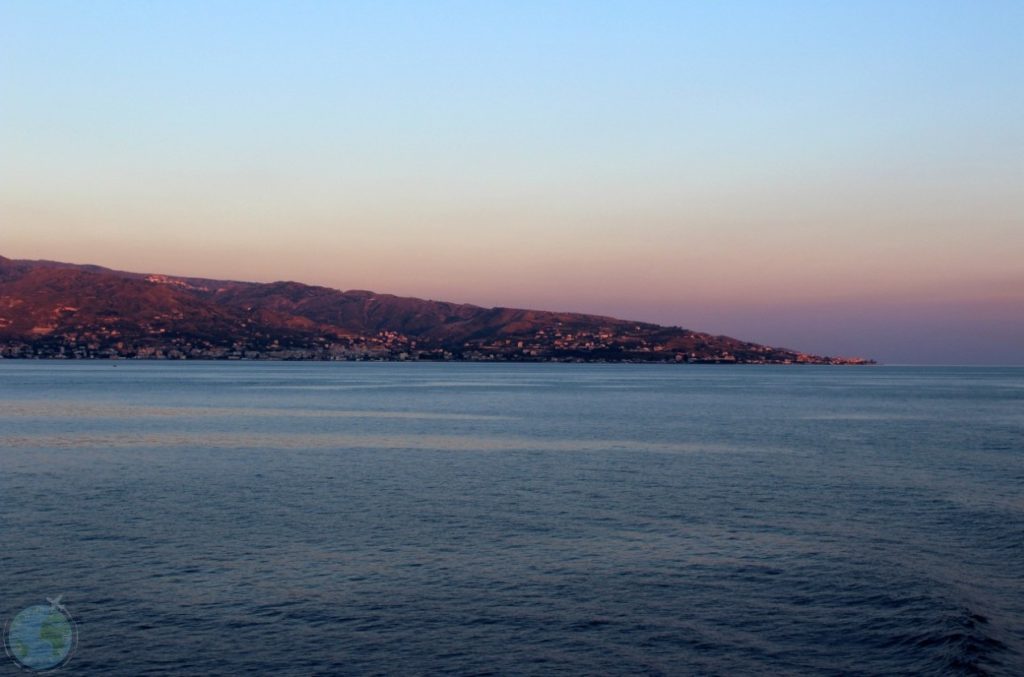
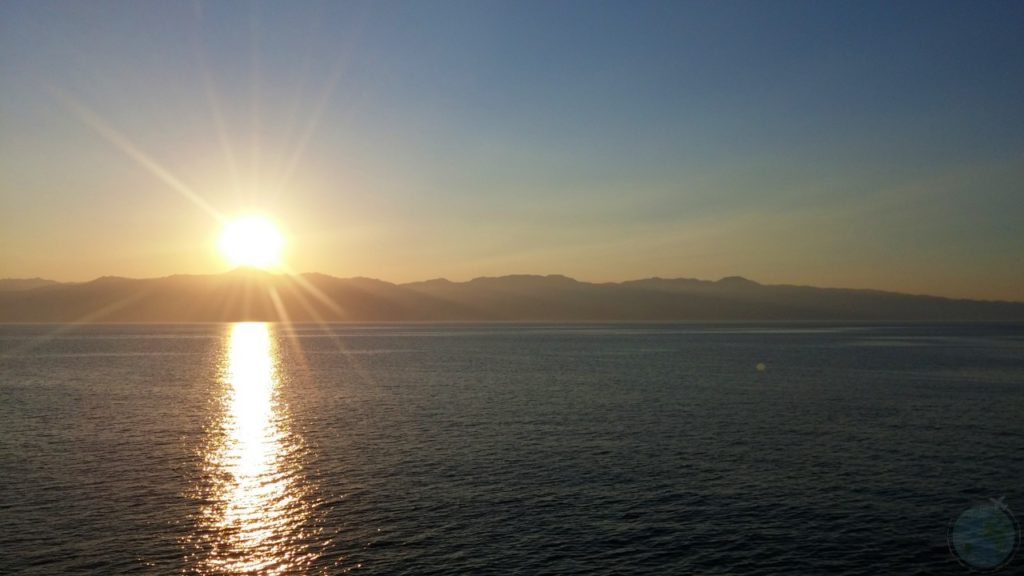
Sunset over Sicily in the Strait of Messina
Naples Italy
We arrived in port at Napoli (Naples) on day 8, and had reserved a tour, Exclusive Pompeii and Amalfi Drive, again through Shore Excursions Group. They really did an excellent job with the tours, and were less crowded and less expensive than the excursions you could book through the cruise line! Mount Vesuvius looms over Naples, a stark reminder of its historic destructive force. We had views of “the Vesuvio” the entire way from Naples to Pompei. We were amazed to see clusters of people living on the side of the mountain, but our guide assured us that the volcano was closely monitored.
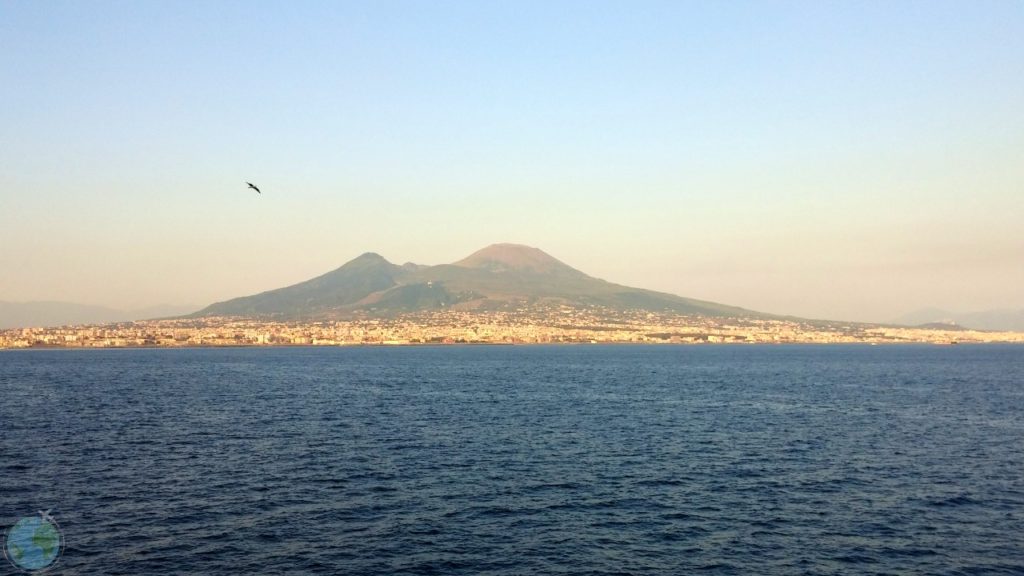
Our day in Pompei was very educational in so many, many ways! Pompei is fascinating! It was founded sometime in the late 7th or early 6th century BC near the mouth of the Samo River. Pompei would eventually become a wealthy port city. In the 3rd or 4th century BC, Pompei entered the Roman political system as an ally, but then rebelled in 90 BC when they felt socially and politically disrespected by Rome. They were in fact defeated, and in 80 BC became a colony of Rome. Public and private building increased dramatically once Pompei became a Roman colony. In 62 AD an earthquake damaged much of Pompei, and reconstruction was still underway on August 24, 79 AD when Mt. Vesuvius erupted catastrophically, burying Pompei under 20 feet of ash before covering it in lava and thus preserving it for future generations.
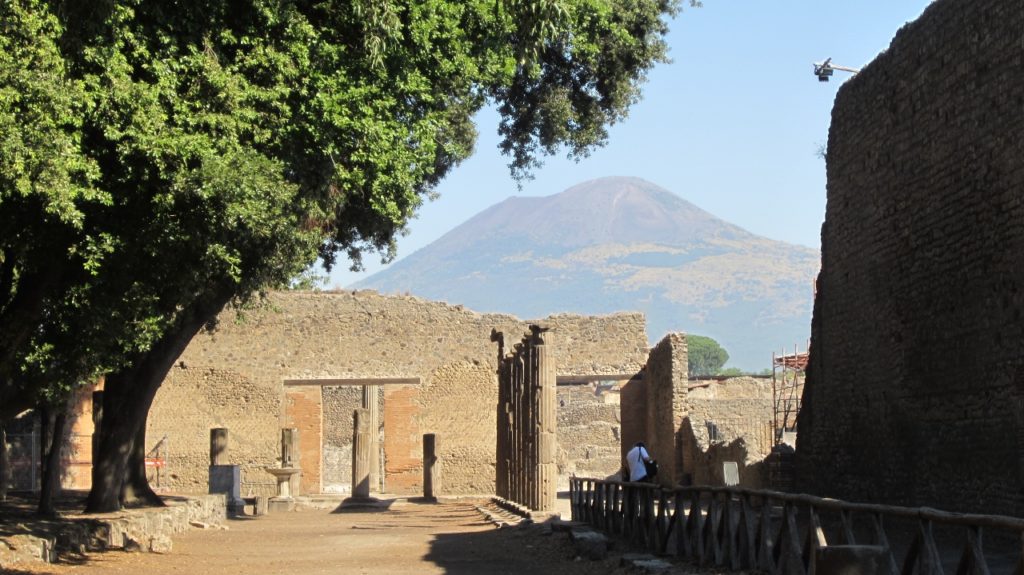
Pompei was rediscovered in the 16th century and exploration began in 1748 under Charles III of Bourbon, King of Naples. In the 1800s, it was discovered that the “empty” places in the ash were actually places where organic things (like people, plants, and animals) had been. They began drilling into these spaces and filling them with plaster before excavating any further. This is where the “bodies” people speak of come from. They are not actually bodies, but plaster casts of the space that a body previously filled. Many of these plaster casts are on display in the Granary in the Forum of Pompei. Today, Pompei is about 75% excavated.
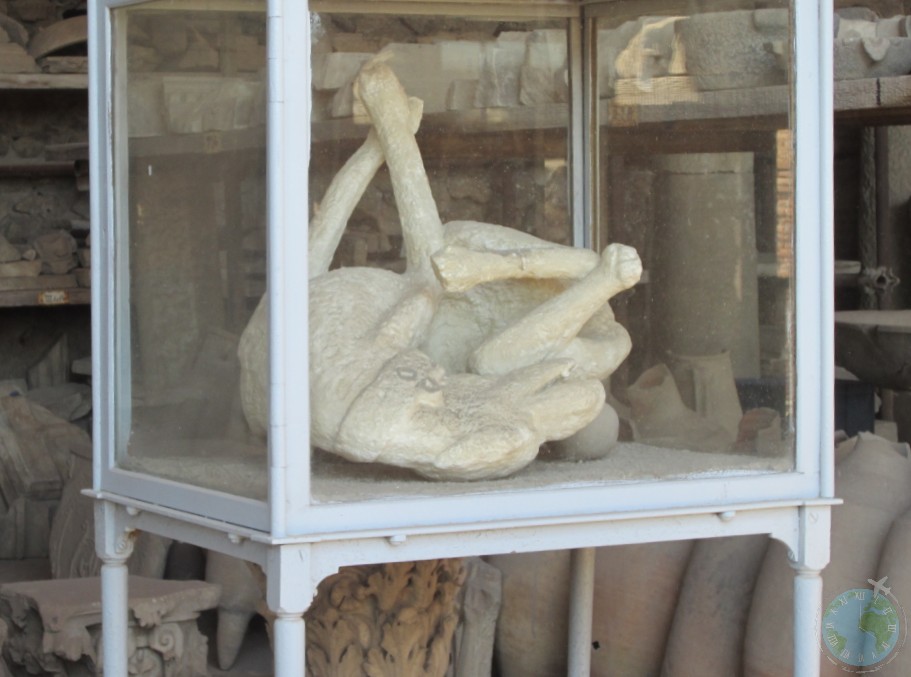
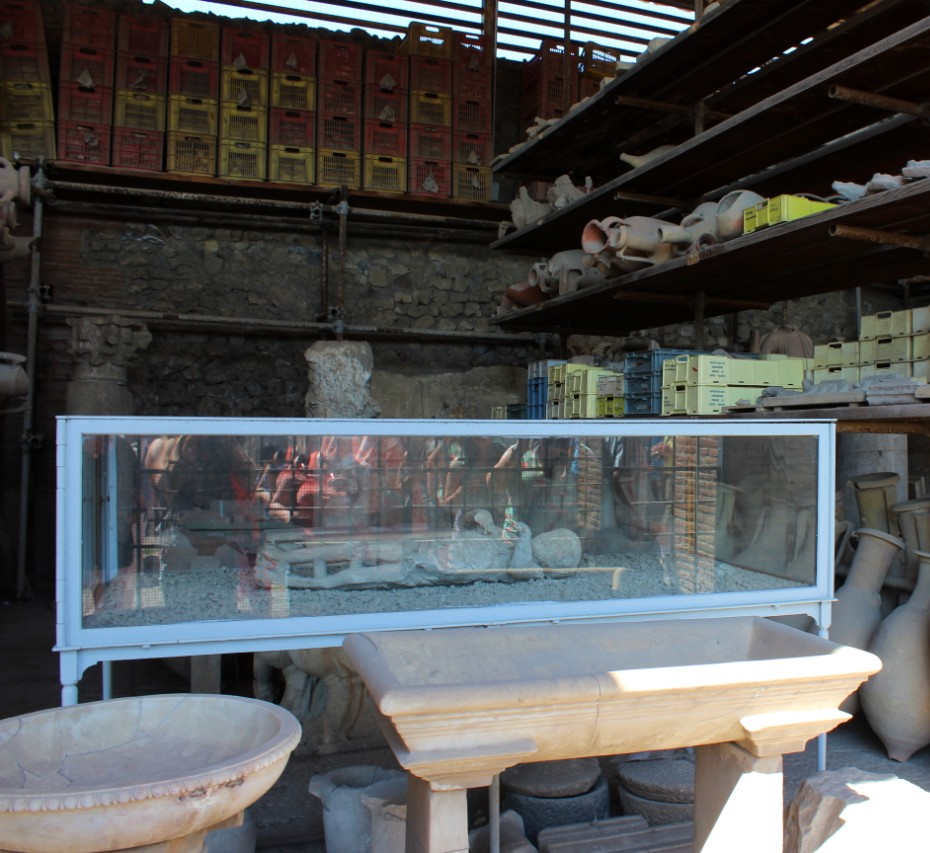
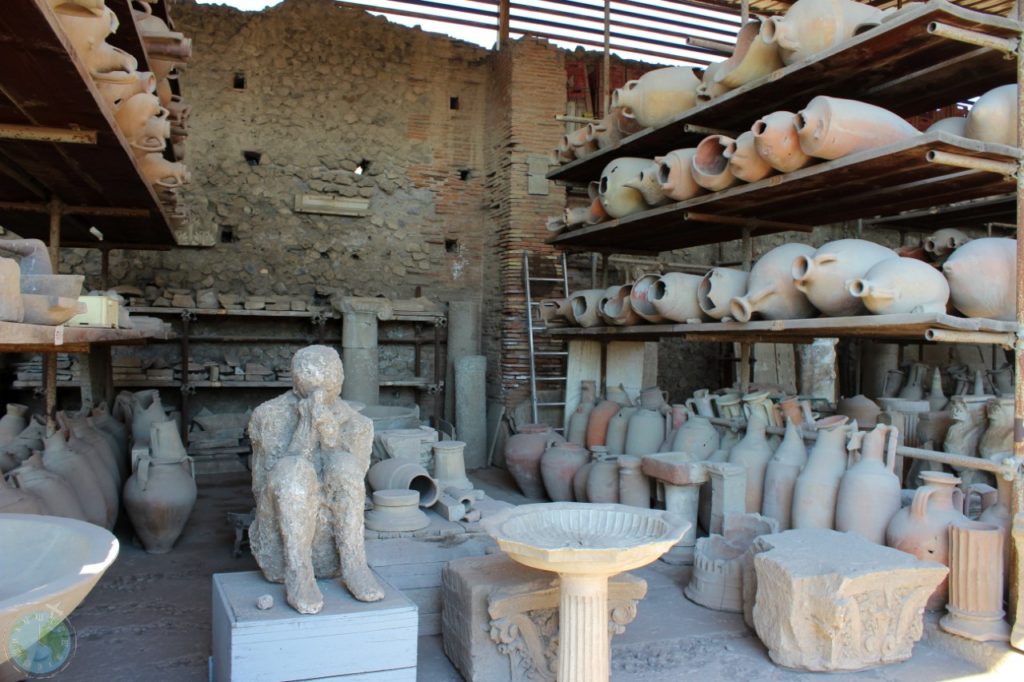
Plaster casts on display in Pompei
We entered Pompei through a gymnasium, a rectangular field surrounded by columns and porticos. It is believed that the area was used by patrons of the theatre during intermissions, and then eventually it became barracks for gladiators. After walking around the gymnasium and climbing a series of stairs, we saw the ruins of a Doric temple thought to be built in the 6th century BC and dedicated to Athena and Hercules. Our next stop was the Great Theatre built into the hillside in the 2nd century BC. Its seating is divided into tiers with the lower tier made of marble. These seats were reserved for members of the Senate. The backdrop was built during the reconstruction efforts after the earthquake in 62AD. You could also see holes in the back walls of the seating area where poles would have been inserted to support the giant awning that would have been stretched out over the crowd to shelter from sun or rain.
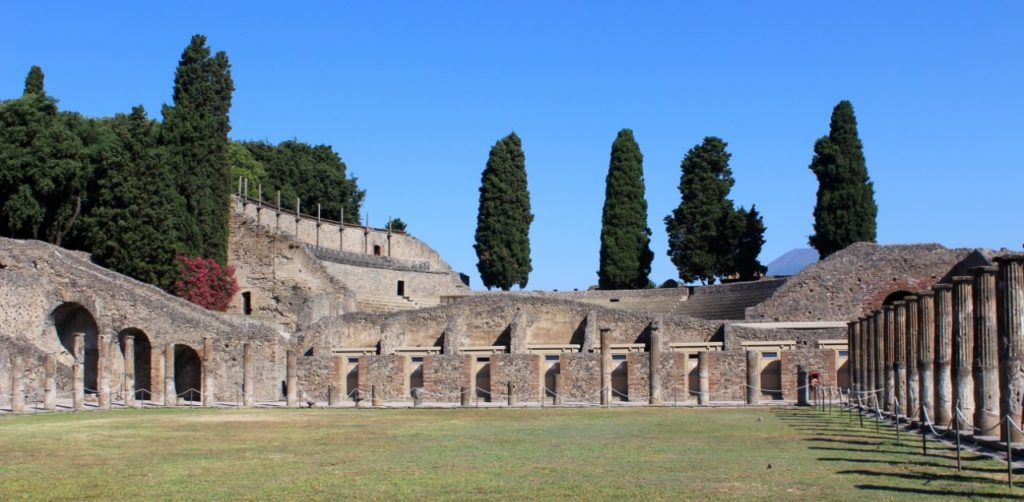
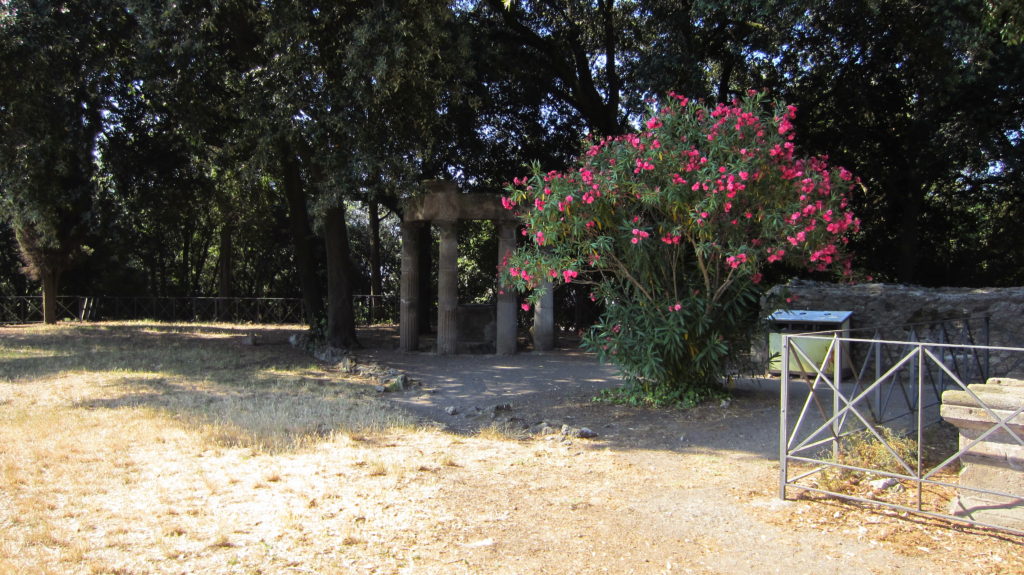
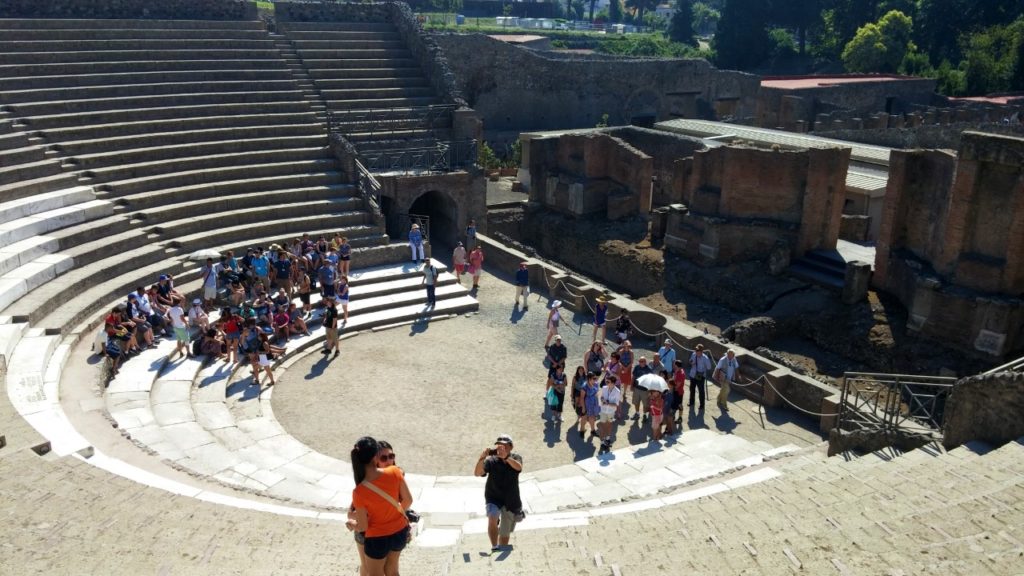
So when I say our tour was educational in many ways, I mean it. For those with younger kids or those who are easily embarrassed, be forewarned, we did not get the rated-PG tour. In fact, to listen to our tour guide, you would think the entire community was completely obsessed with sex. Our guide was sure to point out all of the phallic symbols we passed by. Most of these were either on the side of a building identifying it as a brothel, or on the road “pointing” the way to the brothel. I will leave this to your imagination.
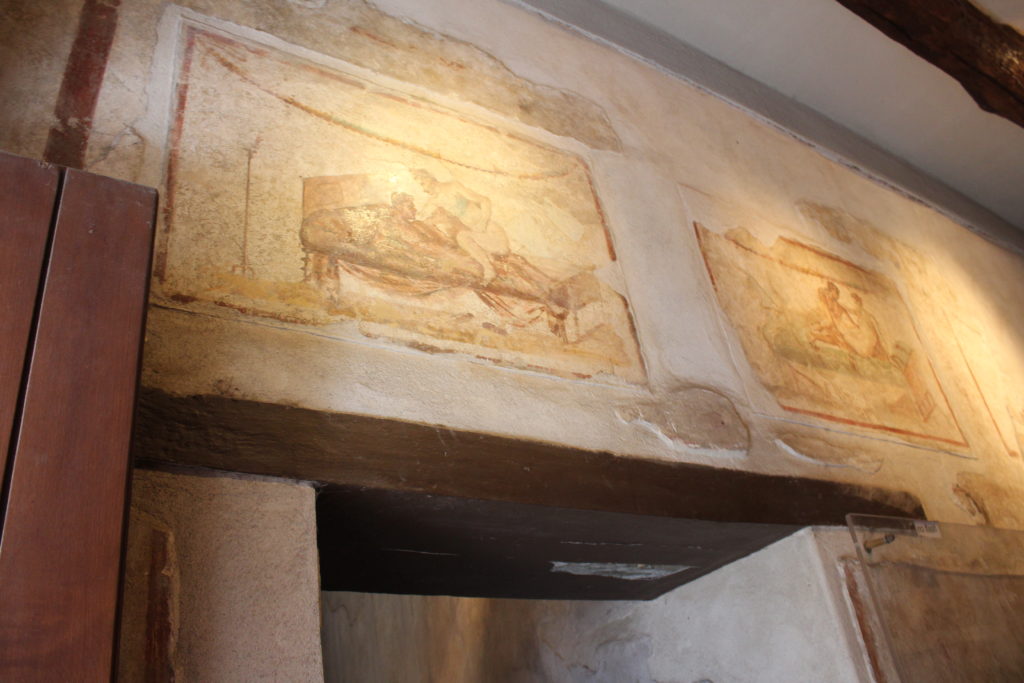
Pompei had several legal brothels, one of which we visited. On the walls near the ceiling, the “menu” of services had been painted in frescos and was very well preserved. It clearly included a variety of positions and preferences. The menu was visual to avoid any language barrier (remember it was a port city). Customers could come in and point at what they wanted. Like I said, it was very educational. On a side note, if you happen to visit the traveling exhibit, Pompeii: The Immortal City, with your kids, be advised that there is a mock up of the brothel in the exhibit, but it can be easily avoided if you know it’s there. This is, by the way, a fantastic exhibit!
Speaking of roads, the roads were fascinating! The main roads were built running east to west with the sun, and smaller roads ran north to south. The main roads were constructed with pieces of white marble scattered throughout to serve as reflectors of the moonlight at night so the road could be seen. There were also several roads where you could see “chariot tracks” worn into the stone. These were deep ruts worn into the rock by the wheels of chariots and carts. All of the roads had a curb and were lower than the sidewalks. The roads also have raised step stones every so often that served as a crosswalk of sorts. They were raised so that people did not have to walk in the street itself which was dirty and often full of waste, and separate stones to allow wheeled carts and chariots to pass through.
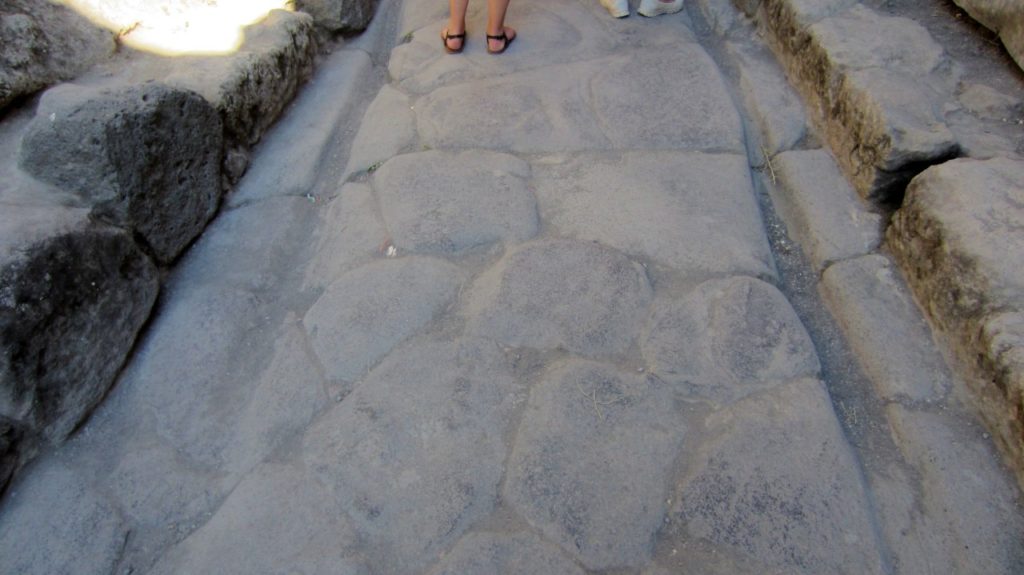
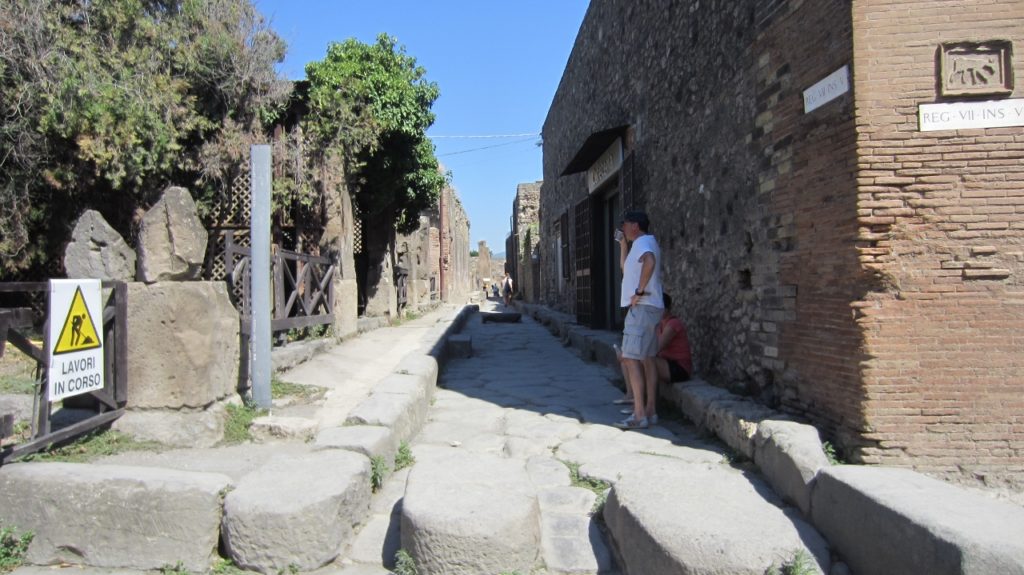
Working our way toward the Forum, we walked along several streets that had contained shops. The shops had sliding doors, and the shop owners typically lived upstairs above their shop. The Forum is the most complete example of a forum (or agora) in Italy. Construction of the Forum began in the 2nd century BC. The entire forum had originally been paved in white marble, again to reflect moonlight and light up the area, and was designated as pedestrian only – no carts allowed! The Forum was the main square in Pompei and was surrounded by religious, political and business structures.
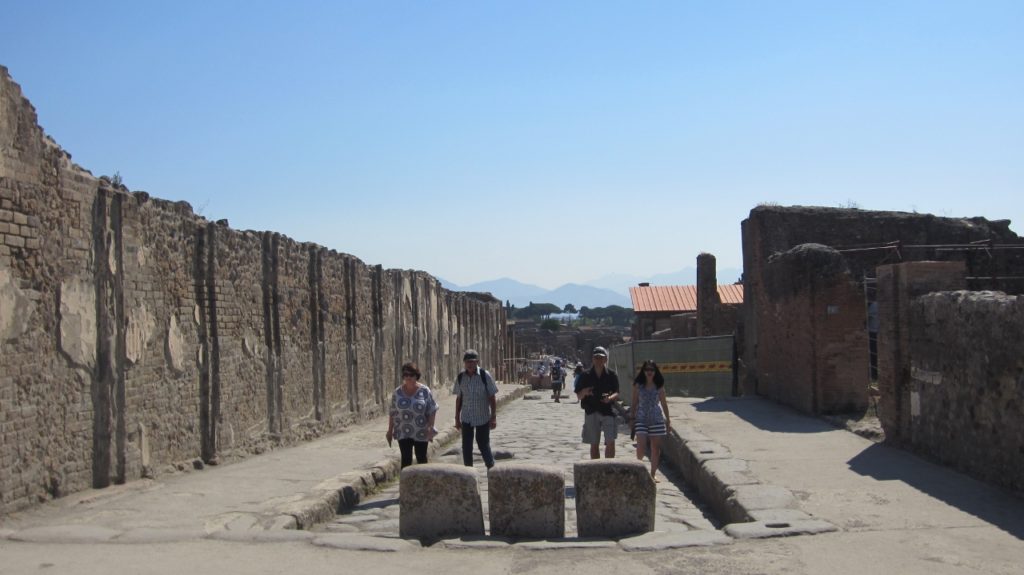
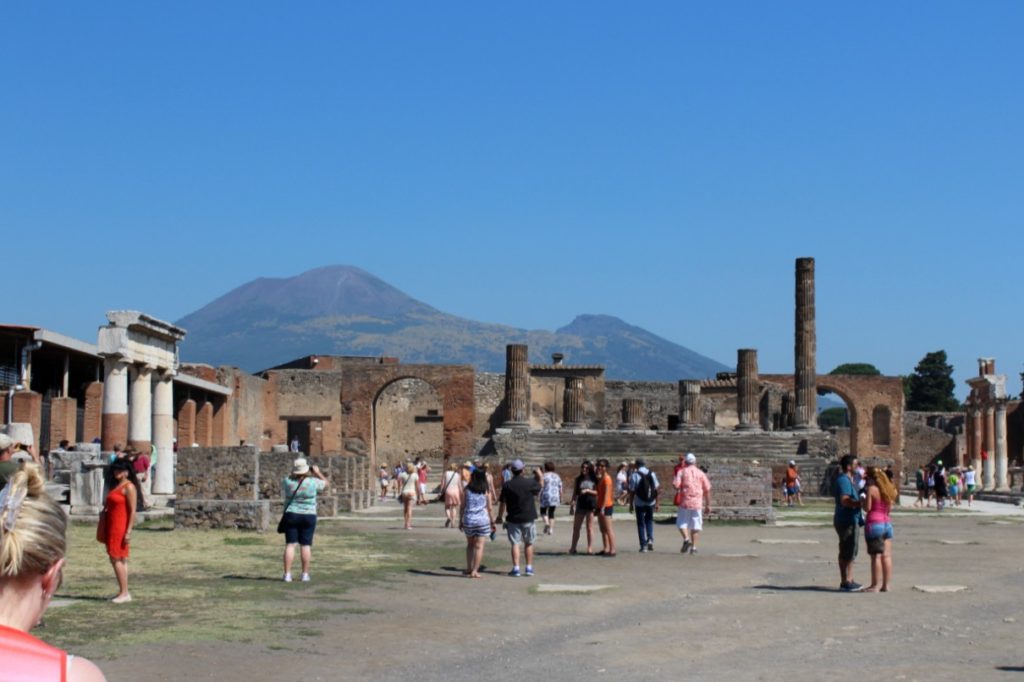
My favorite ruins in the forum belong to the 2nd century BC Basilica. It just looks cool with what is left of its two stories of columns. The Basilica was not used for religious services like we think of a basilica, it was instead more like the courtroom or boardroom where justice was administered and business negotiations took place. We really could have spent an entire day in just the Forum. What is left of the Temple of Jupiter is also located in the forum with the imposing Vesuvius as a backdrop. This temple was also built in the 2nd century BC and was, of course, dedicated to the Roman god Jupiter. Later, it was converted into a Capitolium and dedicated to the Capitoline Triad of Jupiter, Juno, and Minerva. Lastly, be sure you don’t miss the Granary in the Forum! This was the produce market constructed after the 62 AD earthquake. The Granary is also where artifacts and plaster casts are on display!
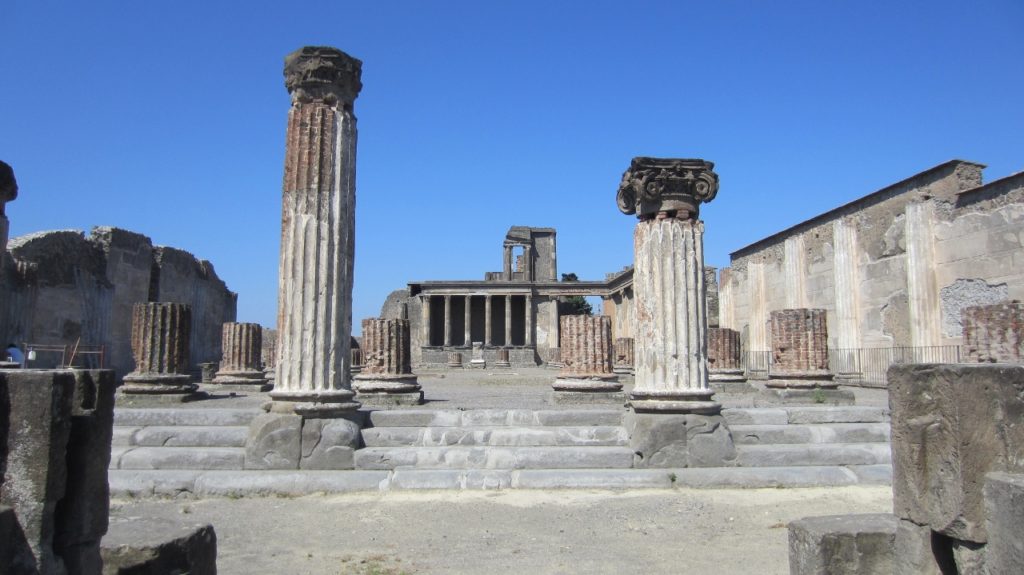
One last tip for Pompei: be prepared – it is HOT in the ruins and there is little to no shade. Sunglasses, sunscreen, and a hat are highly recommended. Take some water. Purses and bags were not permitted, so plan accordingly. I loved visiting this site and you could literally spend DAYS here and probably not see everything! I would have loved more time to explore on my own, but alas a cruise port for the day only allows so many hours. Next time!
The second half of our excursion included the Amalfi Coast. What a beautiful drive! It took about an hour and a half to get from Pompei to Positano where we got off the bus to spend some time on our own. I cannot imagine being the bus driver! There were so many hairpin turns and narrow roads and steep hills! The views, however, are breathtaking! From the terraced lemon, olive, and grape farms to the cliffs plunging into the clear blue Tyrrhenian Sea!
Once we arrived in Positano, we walked around the town for a bit and then took a boat ride up the coast! We stopped at a place called the Emerald Grotto (not to be confused with the Blue Grotto) even though the water was very blue! This grotto has a second opening 10 meters below the surface of the water, which allows light to enter and gives the water a beautiful eeries glow! I would have enjoyed this even more had I not forgotten my glasses! To enter this grotto, you exit the tour boat, and board a smaller boat just inside the grotto. I realized too late that I was still wearing my sunglasses, so it was either everything was a whole lot darker or everything was too blurry to recognize! I went with darker! What a bummer. The Emerald Grotto has a marble (I think) Nativity sunken to the bottom that you can see from above, so that was neat. The cave formations were also pretty.
After the boat ride, we had just enough time to wade into the water for a bit at the beach and eat some amazing gelato before boarding the bus to return to Naples. We took a different way back to Naples completing the Amalfi Coast Drive and saw even more beautiful scenery and terraced towns nestled into cliffs. I was truly grateful that I was not driving, as there is no way I would have been able to enjoy the scenery. I would have been concentrating on the road too much! Our guide told us that the entire drive is approximately 54 kilometers and has 1002 corners or turns, and I believe it!
Rome Italy
I mentioned all roads lead to Rome, and here we are on day 9 in the port city of Civitavecchia boarding the bus to head down the road to Rome! I was pretty excited about this day as a teacher of ancient history! We were going to see many of the ancient sights I teach about. We again used Shore Excursions Group for our Exclusive Best of Rome tour. Is it possible to see Rome in a day, you ask? Well, it IS possible to see the highlights of Rome in a day, however, I would not advise it!
Getting to the front of the cruise terminal to meet the tour operator was pretty stressful. The ship docked at 8am, and our tour started at 8:30. Our directions requested we be at the meeting point (the front of the cruise terminal) 10 minutes prior to departure, and it was a 20 minute bus ride (with a limited number of buses) from the ship to the front of the terminal. We were in line to get off the boat by 7:30 along with many others. We made it to the rendezvous point, and still our bus left 45 minutes late because several families had difficulties getting off the boat and onto a bus in a timely manner. Another interesting thing happened here, my daughter and I were not on the manifest. Our guide was great about this, I had a copy of my ticket, so she let us on and called in to get it straightened out while we were on the road! Great customer service!
It is incredibly HOT in Rome during the summer, and our tour was very fast paced. This was exacerbated by the facts that we not only left 45 minutes late, but we also had to wait for a traffic accident to clear. It was an hour and a half drive to get into Rome that really only should have taken just over an hour! We did drive the route that was once the ancient Aurelian Way, so that was pretty cool. But there we were starting our Rome in a day with an hour and 15 minute time deficit! Did I mention that it is HOT in Rome? Haha!
Our first stop in Rome was at Vatican City. Our free time to roam around had to be shortened to try and catch up on time. The lines to get into the Vatican were CRAZY long – like 6 people wide and wrapped all the way around the square, out the gate, and down the hill! If you plan to go IN the Basilica, the Museums, or the Sistine Chapel, spend the money and buy a skip-the-line ticket. We got these through Viator the next time we were in Rome. St Peter’s Square was previously a circus, the one in which Peter, the disciple, was crucified upside down, thus the name. The colonnades on either side of Saint Peter’s Basilica are meant to look as if the church is embracing the square. Outside the Vatican we also saw a water fountain that had been made out of an old marble converted casket. The water from which is drinkable so they say. More on this later.
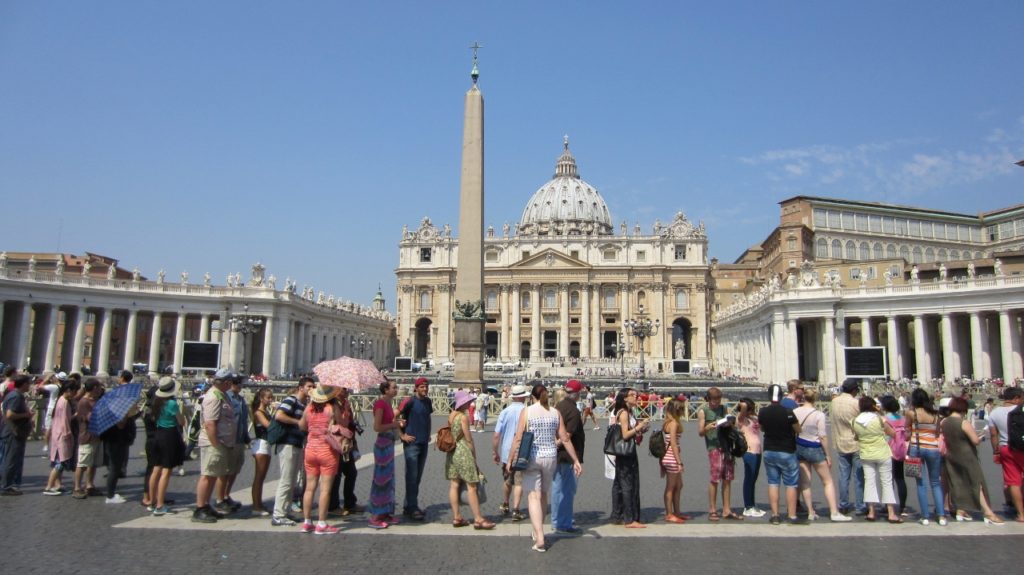
We walked (like a mall-walking pace) 1.6 kilometers to the Piazza Navona, a gorgeous Piazza with 3 huge beautiful fountains. From there we nearly sprinted another half a kilometer to the Pantheon. This ancient temple was dedicated to all Roman gods, and was completed by the Emperor Hadrian in the 2nd century AD. It remains intact and much the same only because it had been converted into a Catholic church. In fact, it still functions as a church today. The dome with the hole in the middle was designed to allow light into the building. To prevent flooding, the floor is slightly sloped and has holes cut into the marble floor to collect rainwater.
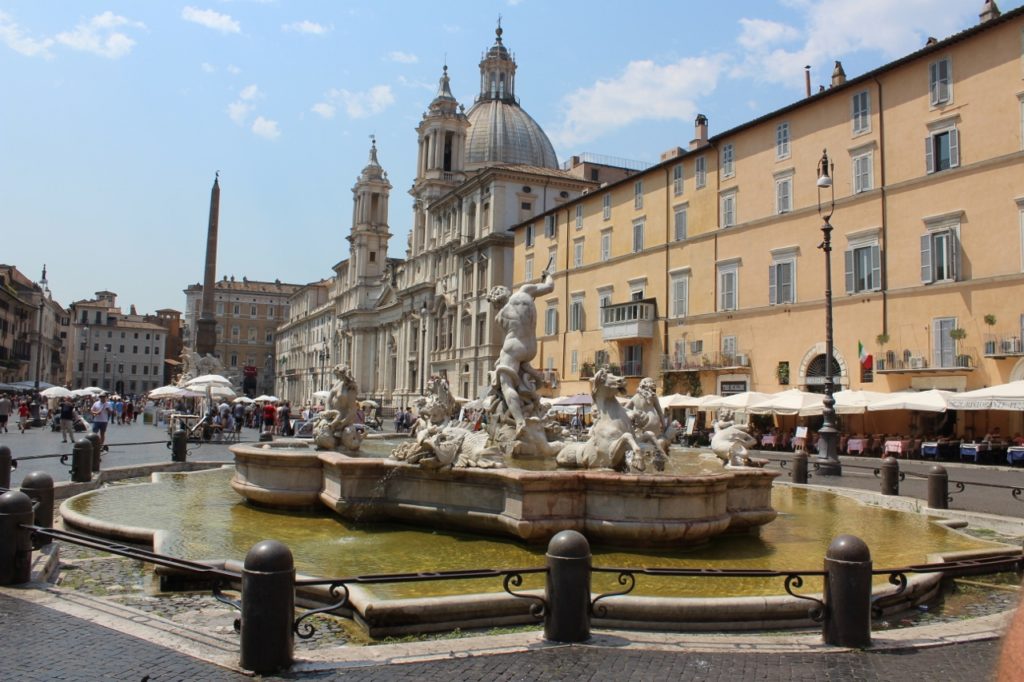
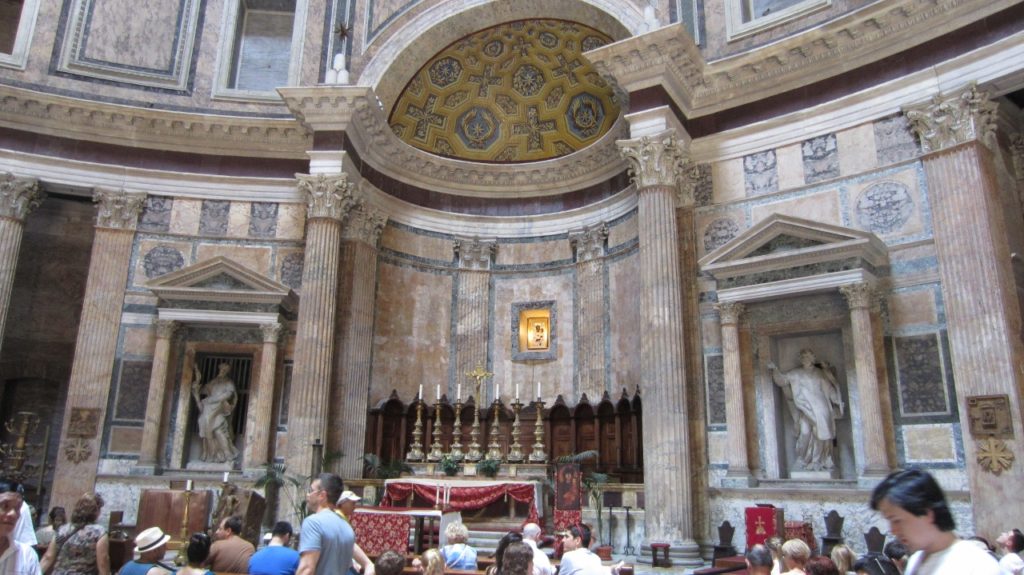
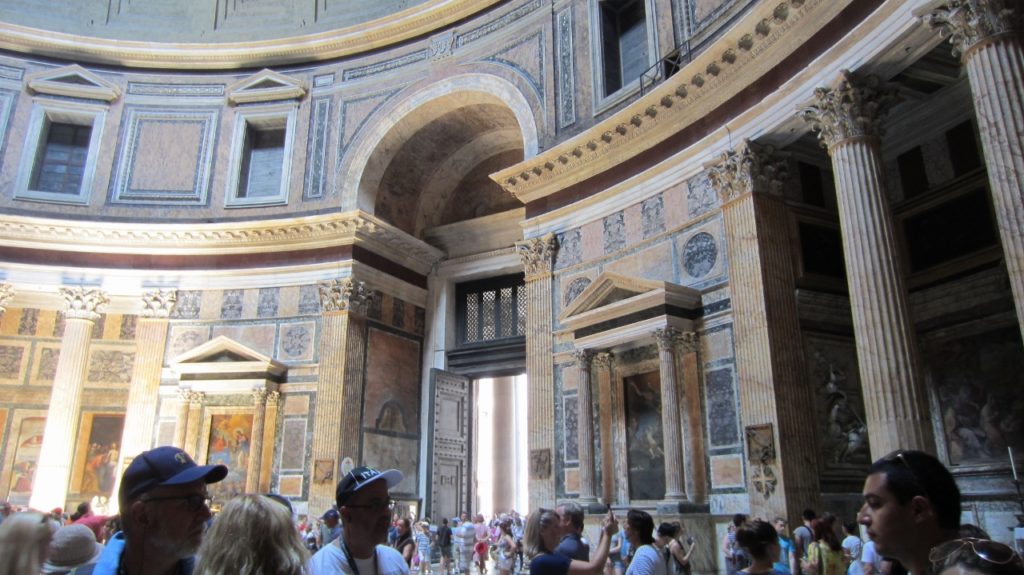
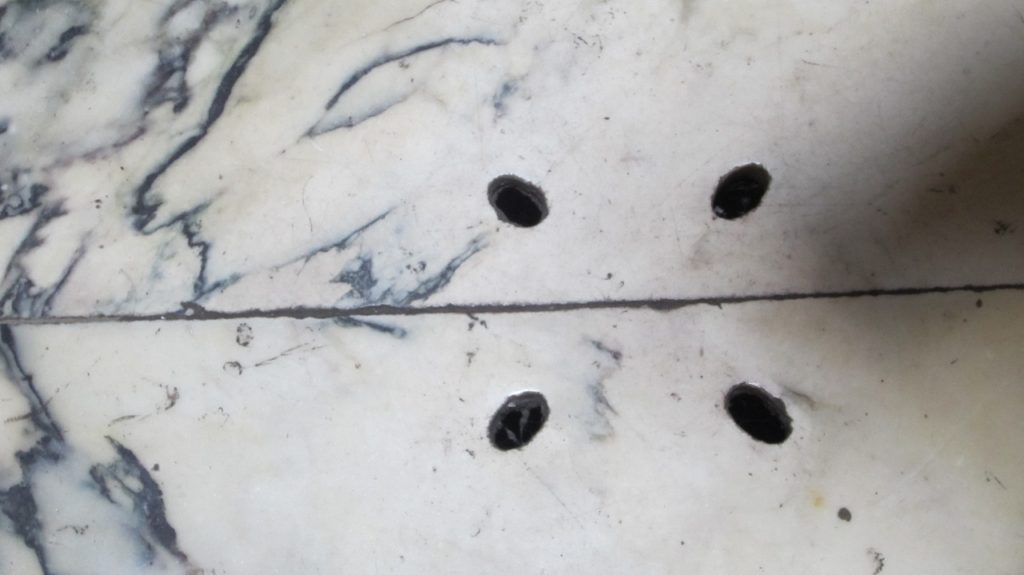
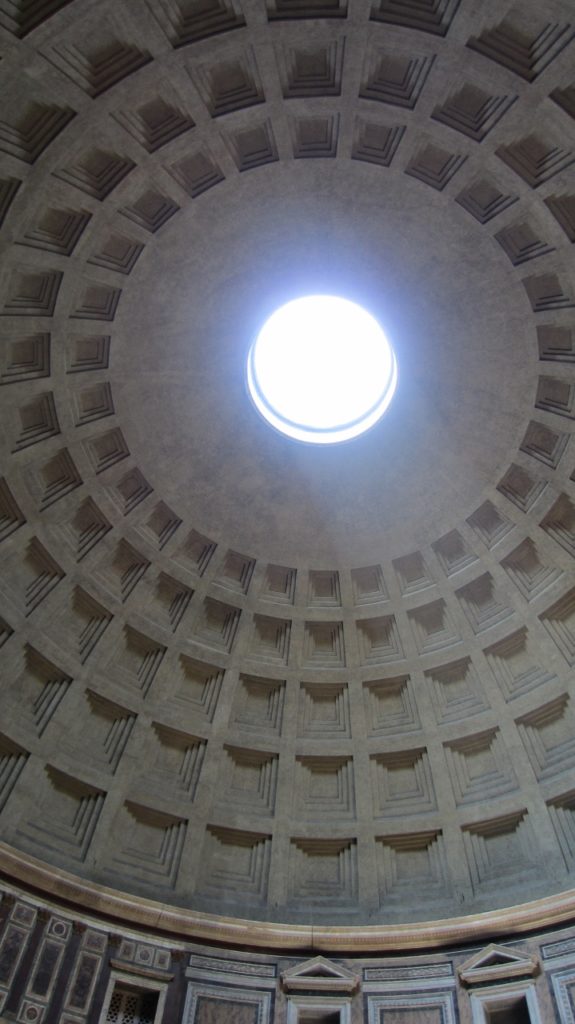
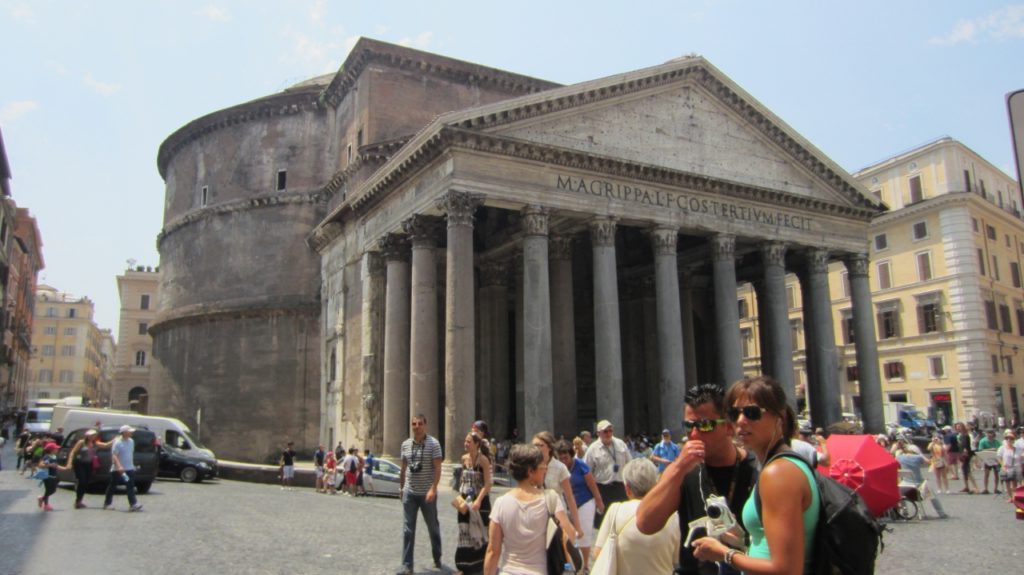
The Pantheon
From the Pantheon, we walked another half a kilometer to the Trevi Fountain. The Fountain was under renovation while we were there, but you could still see it well, there just wasn’t any water running through it or in the basin. I think I was most shocked by this particular location. Having seen many photos of the Trevi Fountain, I had no idea that the square the fountain is in was so tiny! The Fountain takes up most of the square, and thus it gets very crowded. It is nearly impossible to get a photo of the entire facade without a wide-angle lens on your camera – or the panoramic option on your phone, which is what I used but it slightly distorts the image. This was also our very short lunch stop, as we were still trying to make up time.
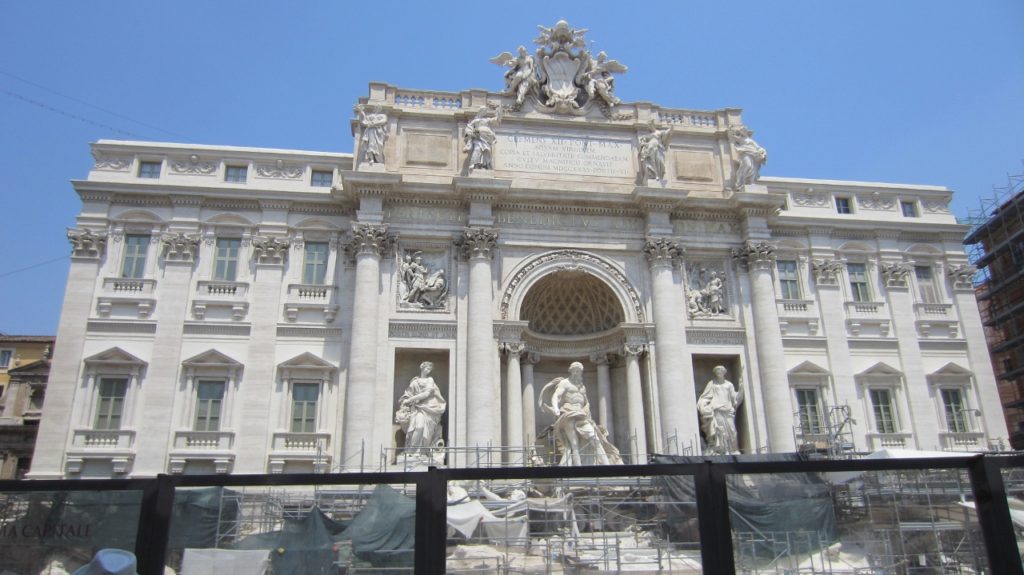
From here, we walked a little further through the Piazza di Pietra to a rendezvous point with the bus. We rode the bus past the Monument to Victor Emanuel II, the first king of a unified Italy, and also the Marcello Theater, built by Julius Caesar. The bus then dropped us off at the base of Capitoline Hill. We climbed I-can’t-tell-you-how-many-stairs (not as many as it seemed because they were wide and uphill?) to the top to see the Campidoglio, a square designed by Michaelangelo.
With the exception of our lunch stop, we had no time to stop for water on our tour because we were so rushed from place to place trying to make up for lost time. Remember the casket fountain at the Vatican? Well, according to our guide, you can refill your water bottle at any of the public fountains in Rome. So I did. I know this is SO FAR OUT OF MY BOX being the germaphobe that I am, but did I mention that it was HOT?!? Desperate times call for desperate measures!
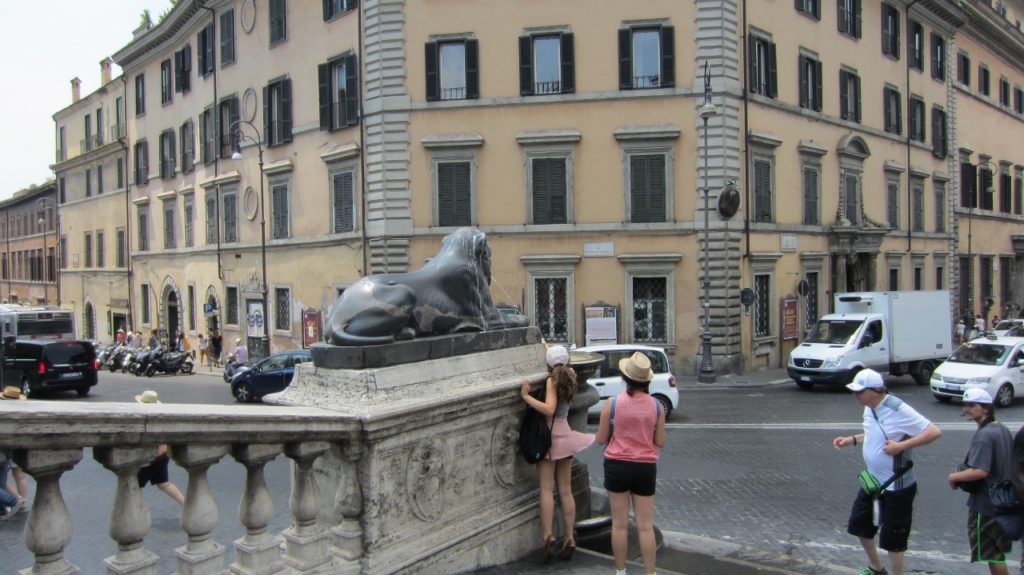
While others wandered the Campidoglio, I went back down I-can’t-tell-you-how-many-stairs to the fountains at the bottom, and water went right from the lion’s mouth into my empty bottle. Then, I had to climb I-can’t-tell-you-how-many-stairs again to rejoin the group. Whether it was the water, the heat, all of those stairs, or a combination of all of the above, I am not sure, but by the end of the day I was sick. Sick. As. A. Dog!
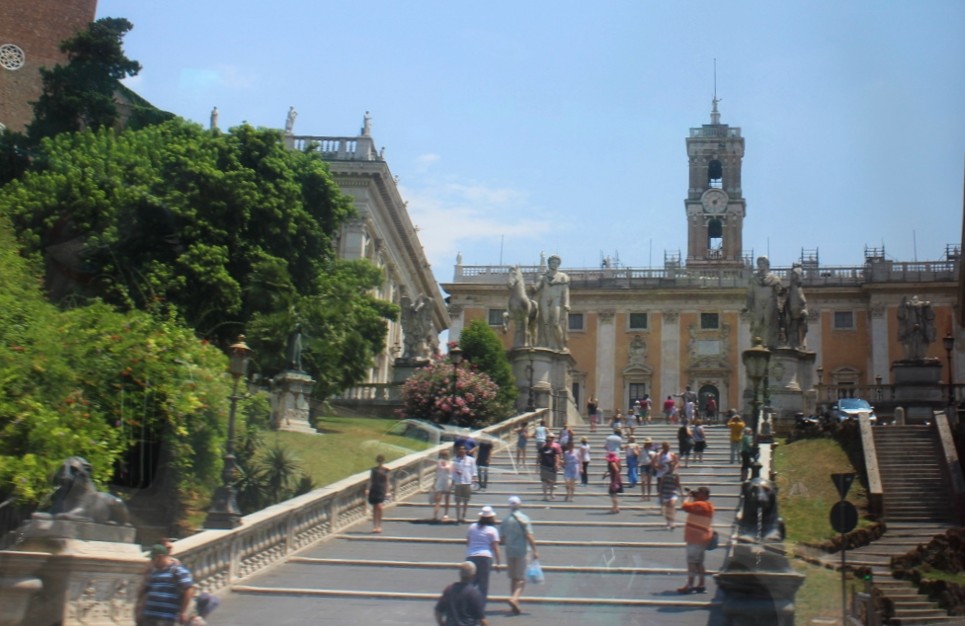
Just beyond the Campidoglio on either side of the Senatorial Palace are some overlooks with fantastic views of the Roman Forum. This is so cool to see in person, especially if you love history! On the left side of the Palace is the Fontana dell’Acqua Marcia, another fountain at which you can fill your water bottle with no-stairs-required, sigh. Also in this immediate area is the Capitoline Wolf sculpture which depicts a nursing Romulus and Remus with their mother, a she-wolf. According to the legend, Romulus and Remus were twins raised by a wolf. Romulus eventually killed Remus and founded the city of Rome.
From the Via di San Pietro in Carcere, we walked another kilometer down the Via dei Fori Imperiali (which was ordered paved by Mussolini) passing by the ruins of Caesar’s Forum, Trajan’s Column, and the ruins of several other Forums: Trajan’s Forum, Forum of Augustus, and Forum of Nerva.
We stopped at the Arch of Constantine, which was built in 315 AD to honor Constantine the Great. And FINALLY, we arrived at the Colosseum! I know our total distance walked was not that outrageous, but did I mention it was HOT? It was a long hard day to get to this point. Haha. People in our group were sweaty and stinky – probably myself included!
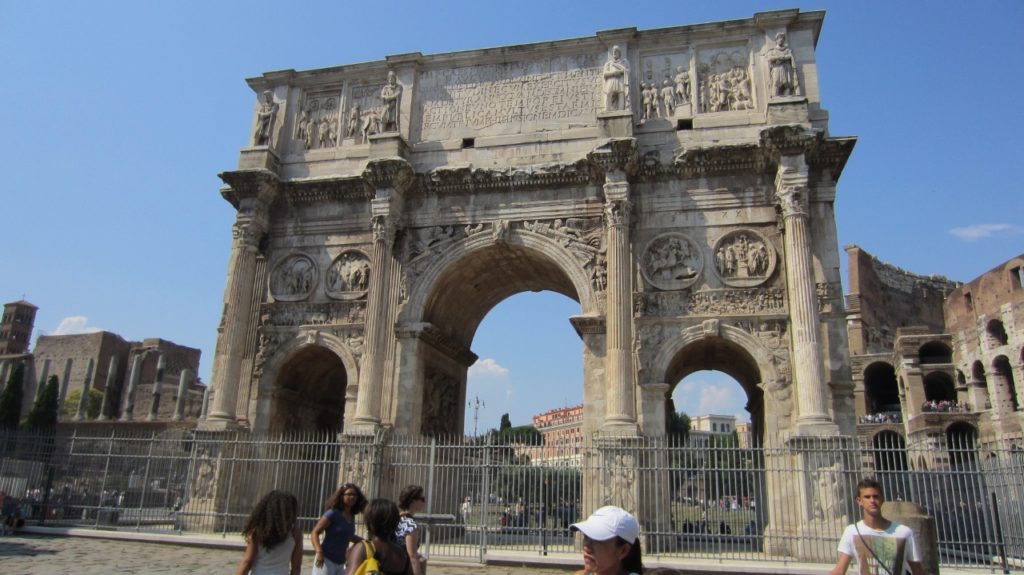
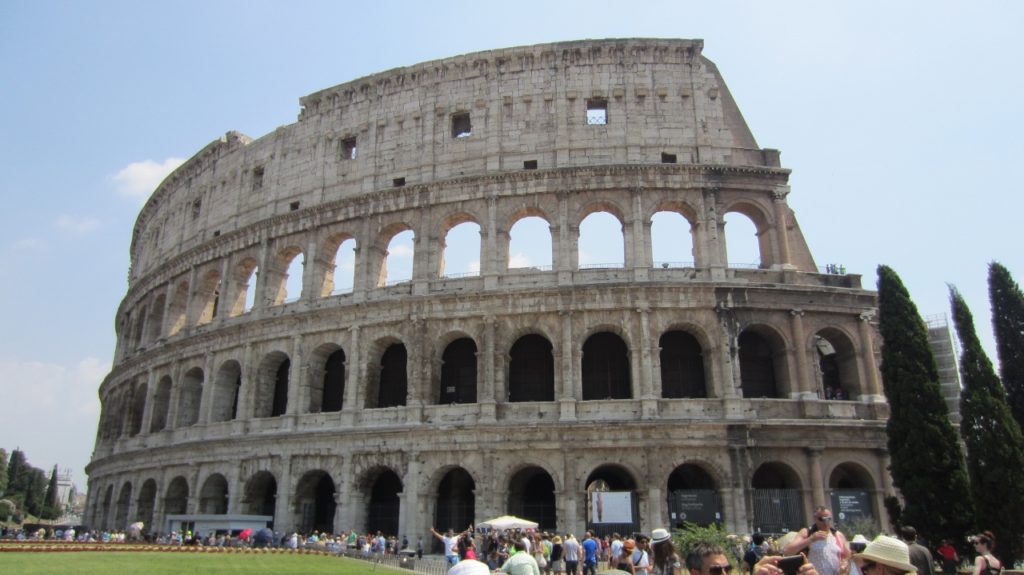
Our final stop of the day was a tour of the inside of the Colosseum. The Colosseum was built on the site of former Emperor Nero’s palace. It was commissioned in 74 AD by the Emperor Vespasian. It is built out of travertine stone (a local limestone that resembles marble) and had three tiers for the 55,000 spectators it could hold. The first tier was made of marble, the second of travertine, and the third of wood. Of course, the wealthier or higher class you were, the better seats you had. There was also an awning that could be rolled out much like at the theatre in Pompei.
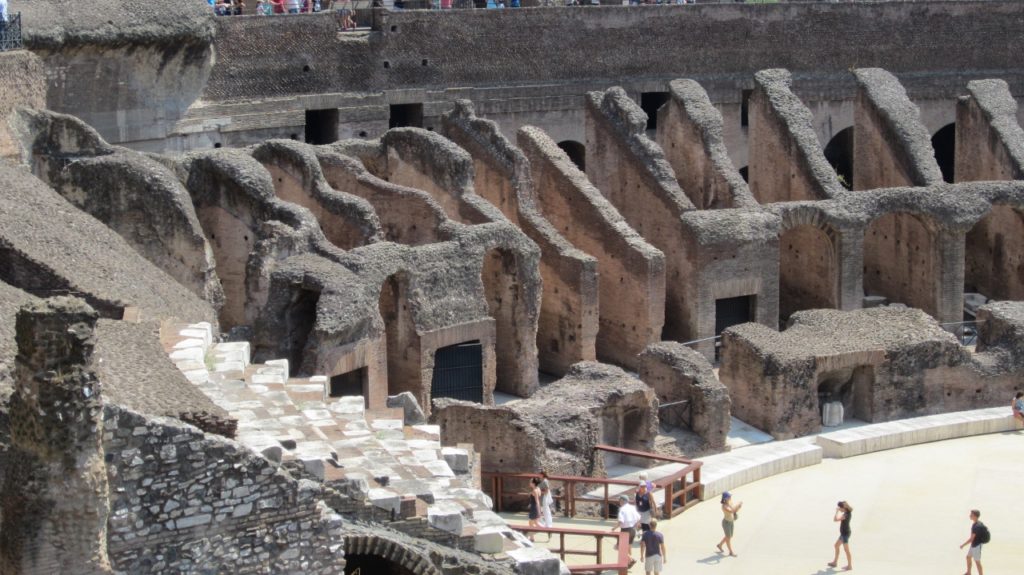
If you go to Rome, again, do yourself a favor and spend the money on a skip the line ticket for the Colosseum. While these are not really completely skip the line because there is also a line of people skipping the line, this line is significantly shorter and moves significantly faster than the general admission ticket line! I was so glad our tour included skip the line admission! Rome is really really crowded in the summer! This was another one of those bucket list sites for me as an ancient history teacher. I was thrilled to have finally arrived! And it did not disappoint!
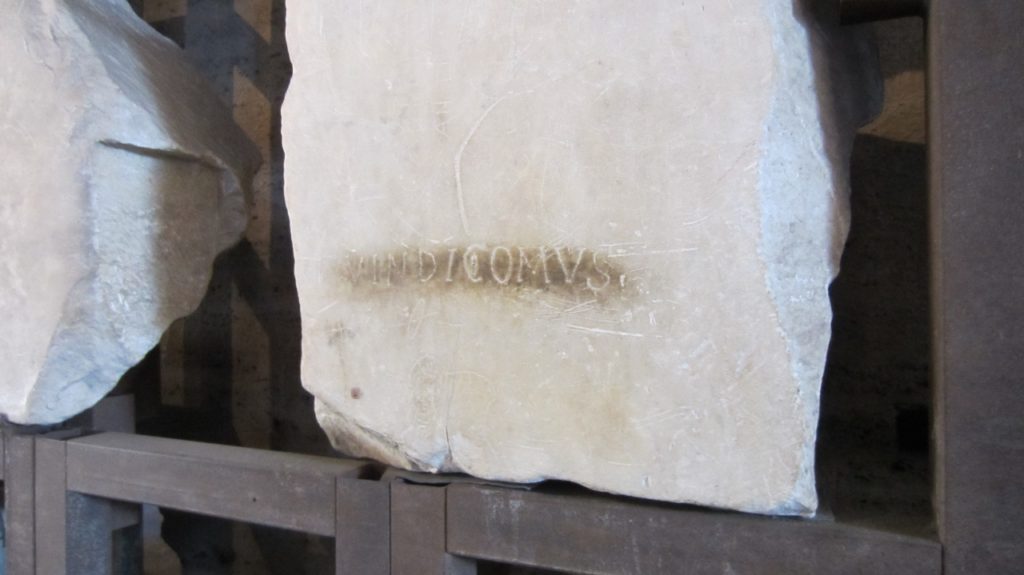
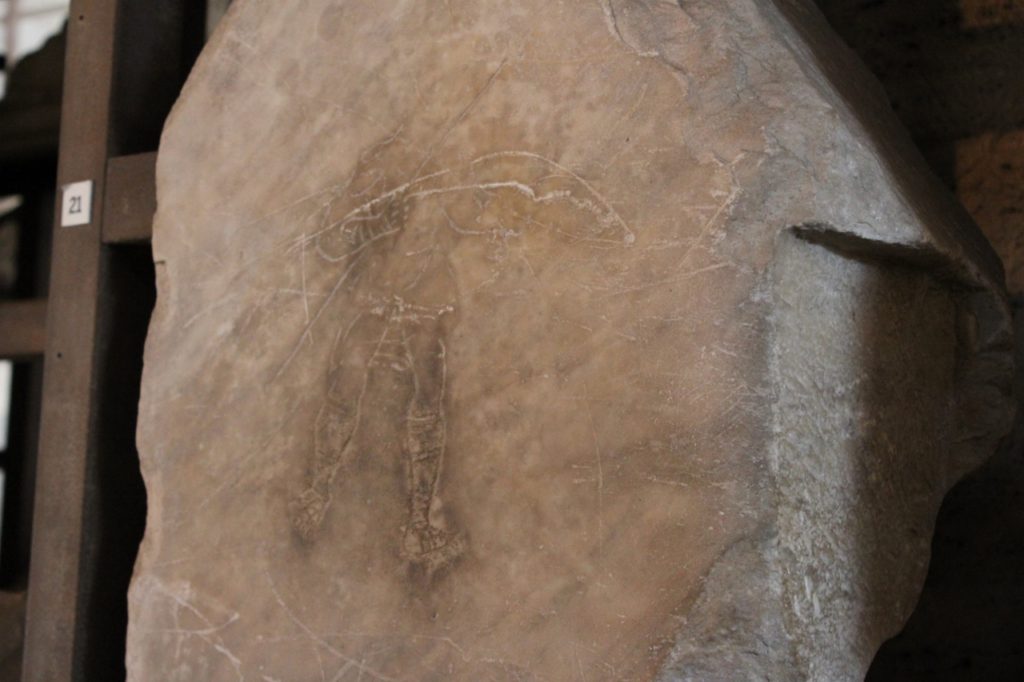
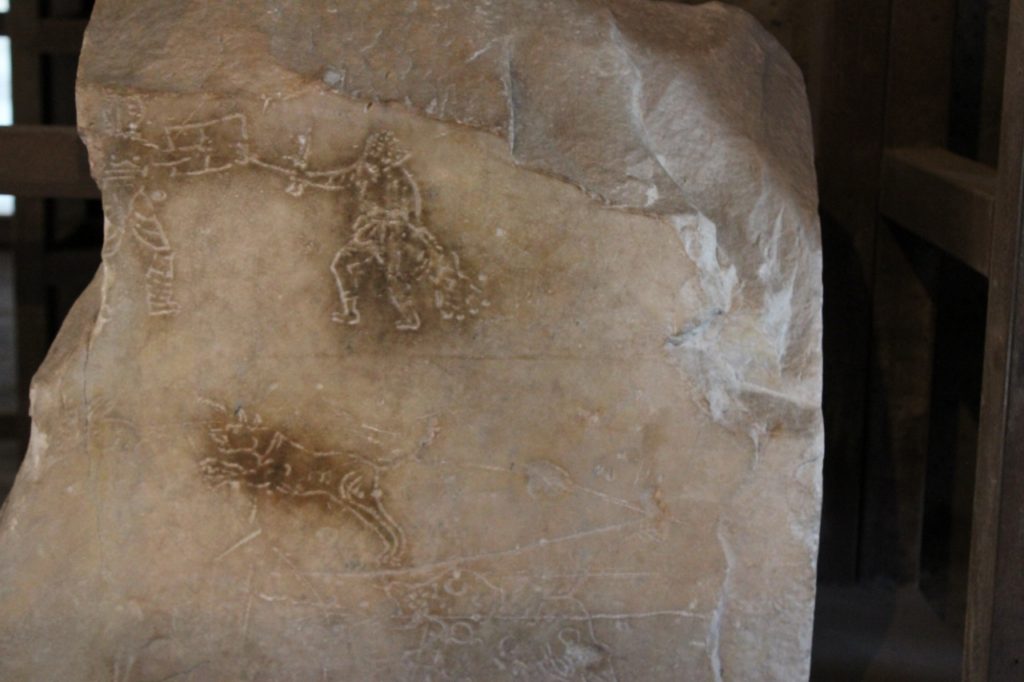
Gladiator Graffiti
Once inside, one of the first things our guide showed us were examples of “gladiator graffiti” – images that had been carved into the stone by gladiators as they awaited their turn in the arena. Did you know that there were a few female gladiators? It is true, although most were men. Most gladiators were either slaves or prisoners.
Another fun fact about the Colosseum is that people lived in it during the Middle Ages. You can see holes carved into the stone walls of all of the walkways about halfway up. We learned that these holes were used to support floor joists when floors were added during the middle ages in order to make more room for more people to take up residence! It was also fascinating to see all of the passages beneath the floor of the arena!
Again, the Colosseum is somewhere that we could have spent hours! If you go to Italy, don’t try to see all of Rome in one day! Even if you are on a cruise, my recommendation is to prioritize what you want to see and spend some quality time at those locations. This is usually my kind of tour for a cruise when I only have a day and I want a quick overview – after all, I like to try to see as much as I can in case I never make it back. And by the end of our day, we had seen so many things that it was amazing, our guide made sure that we saw everything on our itinerary despite the initial delays.
But, I have to be honest, Rome was not my favorite. Yes, it is somewhere that every history lover should go, but once was enough for me. Maybe I would have loved it had I gone in the off-season. It was incredibly crowded, and we had been so rushed that everyone was simply exhausted and several of us were dehydrated (or maybe it was the fountain water). I had to make an emergency bathroom stop prior to boarding the bus back to the boat because I was so sick by the end of the day, and I am in decent shape! I am sure the 45 minute late departure and the 30 minute traffic delay didn’t help, but seriously if you only have a day, set some priorities and focus. And DRINK WATER! Did I mention that it was HOT?!?
Check out Episode 1 Venice & Airport Antics here.
Check out Episode 2 Greece & Turkey here.
Click here for the next episode.


